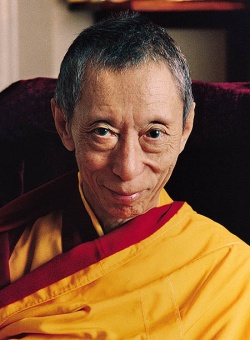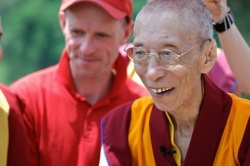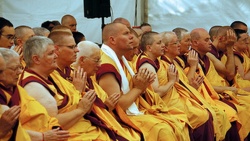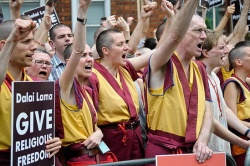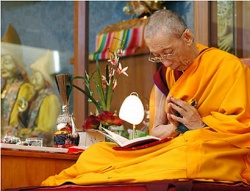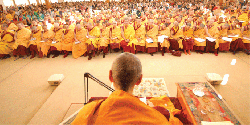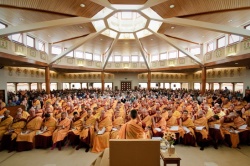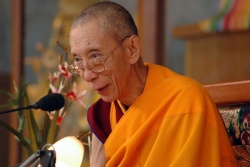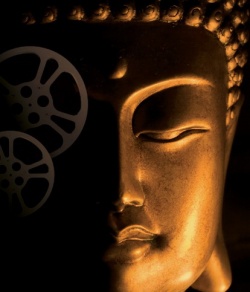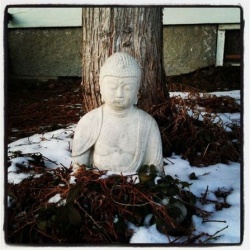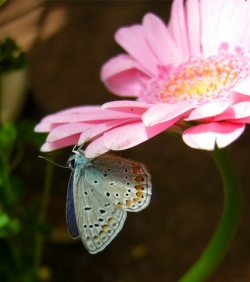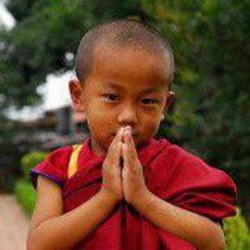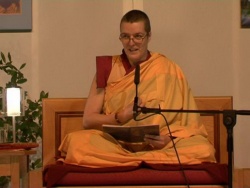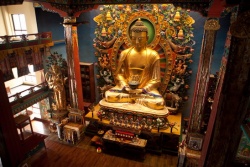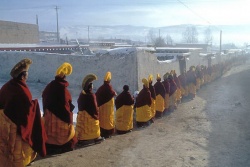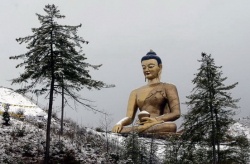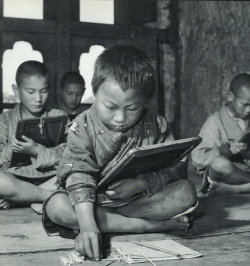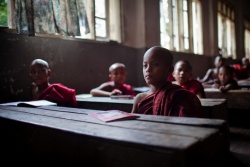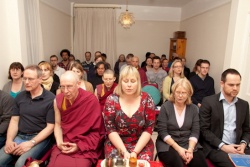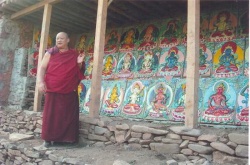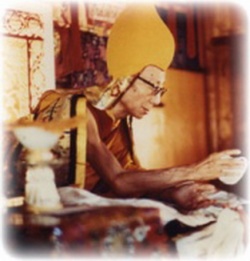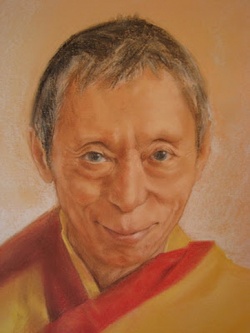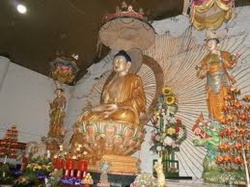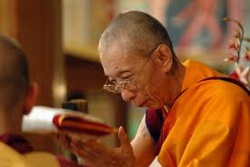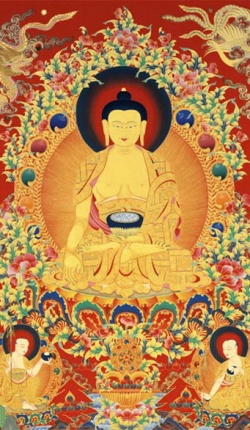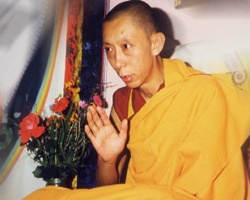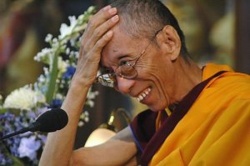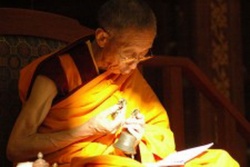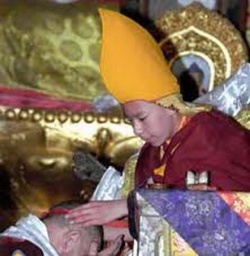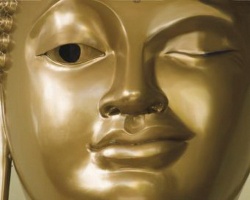Difference between revisions of "New Kadampa Tradition"
m (Text replacement - "]]]" to "]])") |
|||
| (8 intermediate revisions by 3 users not shown) | |||
| Line 1: | Line 1: | ||
| + | [[File:Geshe Kelsang Gyatso.jpg|thumb|250px|]] | ||
<poem> | <poem> | ||
| − | The '''New Kadampa Tradition''' ~ International Kadampa Buddhist Union ( | + | The '''[[New Kadampa Tradition]]''' ~ [[International Kadampa Buddhist Union]] ([[NKT]]—[[IKBU]]) is a global [[Buddhist]] organisation founded by [[Geshe]] [[Kelsang Gyatso]] in England in 1991. In 2003 the words "International [[Kadampa]] [[Buddhist]] Union" (IKBU) were added to the original [[name]] "[[New Kadampa Tradition]]". The [[NKT-IKBU]] is an international organization registered in England as a charitable, or non-profit, company. It currently lists more than 200 centres and around 900 branch classes/study groups in 40 countries. |
| − | + | [[File:403f720.jpg|thumb|250px|]] | |
| − | The NKT-IKBU is a [[Mahayana]] | + | The [[NKT-IKBU]] is a [[Mahayana]] [[form]] of [[Buddhism]], which has been developed from the [[Gelug]] school of [[Tibetan Buddhism]]. The [[NKT]]-IKBU follows the [[tradition]] of [[Kadampa Buddhism]] derived from the [[Buddhist]] [[meditators]] and [[scholars]] [[Atisha]] (AD 982–1054) and [[Je Tsongkhapa]] (1357–1419 AD), as taught by [[Kelsang Gyatso]]. The [[New Kadampa Tradition]] "offers standard [[Gelugpa]] teachings based on [[Kelsang Gyatso's]] [[books]], which present a systematic [[path]] to [[enlightenment]]." However, others [[view]] the [[NKT]] as a breakaway sect or {{Wiki|cult}} and argue it is not part of the {{Wiki|ancient}} [[Kadampa]] [[Tradition]] but a split from the [[Gelug]] school of [[Tibetan Buddhism]]. |
| − | + | [[File:79 af2 n.jpg|thumb|250px|]] | |
| − | Historical background of the formation of NKT | + | Historical background of the formation of [[NKT]] |
| − | + | [[File:Wss est2008.jpg|thumb|250px|]] | |
| − | In 1976 the students of Lama | + | In 1976 the students of [[Lama]] [[Thubten Yeshe]] founded the {{Wiki|Manjushri Institute}}, a registered charitable company with [[Lama Yeshe]] as the [[Spiritual]] Director and purchased the assets of Conishead Priory, a sadly neglected Victorian mansion in Ulverston (Cumbria), England for the price of £70,000.] In the same year [[Lama]] [[Thubten Yeshe]] and [[Lama Zopa Rinpoche]] visited [[Kelsang Gyatso]] in [[India]] and invited him over to teach at the {{Wiki|Manjushri Institute}}, which was a part of their [[FPMT]] network. |
| − | + | [[File:Venhfdtso.jpg|thumb|250px|]] | |
| − | Kelsang Gyatso, a Tibetan Buddhist teacher, monk and scholar from the Gelug Tradition, is a contemporary of Lama Yeshe's from the time they spent studying at Sera Monastery. | + | [[Kelsang Gyatso]], a [[Tibetan Buddhist]] [[teacher]], [[monk]] and [[scholar]] from the [[Gelug Tradition]], is a contemporary of [[Lama Yeshe's]] from the [[time]] they spent studying at [[Sera Monastery]]. |
| − | + | [[File:Temfdple.gif|thumb|250px|]] | |
| − | According to researcher David N. Kay, Kelsang Gyatso was invited in 1976 by Lama Thubten Yeshe and Lama Zopa Rinpoche, who sought the advice of HH the 14th Dalai Lama when choosing Kelsang Gyatso. Whereas according to a NKT brochure, "Lama Yeshe requested Kyabje Trijang Rinpoche to ask Kelsang Gyatso to become Resident Teacher of Manjushri Institute. Kelsang Gyatso later recounted that Kyabje Trijang Rinpoche asked him to go to England, teach Shantideva's Guide to the Bodhisattva's Way of Life, Chandrakirti's Guide to the Middle Way and Lamrim, and then check whether there was any meaning in his continuing to stay." | + | According to researcher David N. Kay, [[Kelsang Gyatso]] was invited in 1976 by [[Lama]] [[Thubten Yeshe]] and [[Lama Zopa Rinpoche]], who sought the advice of HH the [[14th Dalai Lama]] when choosing [[Kelsang Gyatso]]. Whereas according to a [[NKT]] brochure, "[[Lama Yeshe]] requested [[Kyabje Trijang Rinpoche]] to ask [[Kelsang Gyatso]] to become Resident [[Teacher]] of [[Manjushri]] Institute. [[Kelsang Gyatso]] later recounted that [[Kyabje Trijang Rinpoche]] asked him to go to England, teach [[Shantideva's]] [[Guide to the Bodhisattva's Way of Life]], [[Chandrakirti's]] [[Guide to the Middle Way]] and [[Lamrim]], and then check whether there was any meaning in his continuing to stay." |
| − | + | [[File:Media1-li 80.jpg|thumb|250px|]] | |
| − | Kelsang Gyatso was requested by Lama Yeshe to lead the "General Program" of Buddhist study. In 1979 Lama Yeshe installed another Geshe at Manjushri Institute, Geshe Jampa Tekchok, to teach a parallel twelve-year Geshe Studies Programme, which was recognized and validated by the Dalai Lama and which was modeled on the traditional Geshe degree. From 1982 to 1990 this program was led by Geshe Konchog Tsewang. According to a disciple of Lama Yeshe from this time, Lama Yeshe intended the institute "to become the central monastery of the FPMT... one of the early jewels of the FPMT crown" and "the pioneer among the western centers". | + | [[Kelsang Gyatso]] was requested by [[Lama Yeshe]] to lead the "{{Wiki|General}} Program" of [[Buddhist]] study. In 1979 [[Lama Yeshe]] installed another [[Geshe]] at {{Wiki|Manjushri Institute}}, [[Geshe]] [[Jampa Tekchok]], to teach a parallel twelve-year [[Geshe]] Studies Programme, which was [[recognized]] and validated by the [[Dalai Lama]] and which was modeled on the [[traditional]] [[Geshe]] {{Wiki|degree}}. From 1982 to 1990 this program was led by [[Geshe]] [[Konchog Tsewang]]. According to a [[disciple]] of [[Lama Yeshe]] from this [[time]], [[Lama Yeshe]] intended the institute "to become the {{Wiki|central}} [[monastery]] of the [[FPMT]]... one of the early jewels of the [[FPMT]] {{Wiki|crown}}" and "the pioneer among the {{Wiki|western}} centers". |
| − | + | [[File:Ges4ela2.jpg|thumb|250px|]] | |
| − | In the late 1970s, Kelsang Gyatso, without consulting Lama Yeshe, opened up a Buddhist Centre in York under his own spiritual direction. Kay sees this as the beginning of a conflict between Lama Yeshe and Kelsang Gyatso. However, according to Kelsang Gyatso, "the opening of the Centre in York caused not one moment of confusion or disharmony". Kelsang Gyatso was asked to resign so that another Geshe, described by Kay as "more devoted to FPMT objectives", could take over as a resident teacher of Manjushri Institute. Many students of Kelsang Gyatso petitioned him to stay and teach them, and on this basis he decided to remain. In the following years prior 1990 Kelsang Gyatso established 15 centers under his own direction in Great Britain and Spain. | + | In the late 1970s, [[Kelsang Gyatso]], without consulting [[Lama Yeshe]], opened up a [[Buddhist]] Centre in York under his own [[spiritual]] [[direction]]. Kay sees this as the beginning of a conflict between [[Lama Yeshe]] and [[Kelsang Gyatso]]. However, according to [[Kelsang Gyatso]], "the opening of the Centre in York [[caused]] not one moment of {{Wiki|confusion}} or disharmony". [[Kelsang Gyatso]] was asked to resign so that another [[Geshe]], described by Kay as "more devoted to [[FPMT]] objectives", could take over as a resident [[teacher]] of [[Manjushri]] Institute. Many students of [[Kelsang Gyatso]] petitioned him to stay and teach them, and on this basis he decided to remain. In the following years prior 1990 [[Kelsang Gyatso]] established 15 centers under his own [[direction]] in {{Wiki|Great Britain}} and {{Wiki|Spain}}. |
| − | + | [[File:Budfgtion.jpg|thumb|250px|]] | |
| − | Both David Kay and Daniel Cozort describe the management committee of Manjushri Institute from 1981 onwards as made up principally of Kelsang Gyatso's closest students, also known as "the Priory Group". According to Kay, "The Priory Group became dissatisfied with the FPMT's increasingly centralized organisation." Cozort states that different disagreements "led to a rift between Lama Yeshe and his students and Geshe Kelsang Gyatso and his, and eventually the Manjushri Board of directors (comprised of Geshe Gyatso's students) severed the connection of the between institute and FPMT." According to Kay, Lama Yeshe tried at different times to reassert his authority over the Institute, but his attempts were unsuccessful. Kay goes on to describe an open conflict of authority which developed between the Priory Group and the FPMT administration in 1983. In February 1984 the conflict was mediated by the Office of His Holiness the Dalai Lama in London. Kay states that after the death of Lama Yeshe in March 1984, the FPMT lost interest because they saw it as a fruitless case. Since that time, Kay states, the Manjushri Institute has developed mainly under the guidance of Kelsang Gyatso without further reference to the FPMT, but legally remained part of the FPMT until late 1990. | + | Both David Kay and Daniel Cozort describe the management committee of {{Wiki|Manjushri Institute}} from 1981 onwards as made up principally of [[Kelsang Gyatso's]] closest students, also known as "the Priory Group". According to Kay, "The Priory Group became dissatisfied with the FPMT's increasingly centralized organisation." Cozort states that different disagreements "led to a rift between [[Lama Yeshe]] and his students and [[Geshe Kelsang Gyatso]] and his, and eventually the [[Manjushri]] Board of directors (comprised of [[Geshe Gyatso's]] students) severed the {{Wiki|connection}} of the between institute and [[FPMT]]." According to Kay, [[Lama Yeshe]] tried at different times to reassert his authority over the Institute, but his attempts were unsuccessful. Kay goes on to describe an open conflict of authority which developed between the Priory Group and the [[FPMT]] administration in 1983. In February 1984 the conflict was mediated by the Office of [[His Holiness]] the [[Dalai Lama]] in {{Wiki|London}}. Kay states that after the [[death]] of [[Lama Yeshe]] in March 1984, the [[FPMT]] lost [[interest]] because they saw it as a fruitless case. Since that [[time]], Kay states, the {{Wiki|Manjushri Institute}} has developed mainly under the guidance of [[Kelsang Gyatso]] without further reference to the [[FPMT]], but legally remained part of the [[FPMT]] until late 1990. |
| − | + | [[File:Bufgha.jpg|thumb|250px|]] | |
| − | According to Kay, of the two Geshes at Manjushri Institute, it was Kelsang Jyatso who had always taken the greater interest in the running and direction of the Institute, and most of the students there were closer to him. The courses offered by both Geshes complemented each other, but as Kay remarked, they "differed in one important respect: only Geshe Kelsang's General Programme included courses on Tantric Buddhism, and attendance upon these required the reception of a Tantric empowerment." Further, Kay argues that "Lama Yeshe's and Geshe Kelsang's different ideological perspectives provided the conditions for the organisational dispute between the Institute and the FPMT to escalate. Kelsang Gyatso was already predisposed to support his students in their struggle with the FPMT administration because the organisation was inspired by a vision that he did not totally agree with." | + | According to Kay, of the two [[Geshes]] at [[Manjushri]] Institute, it was [[Kelsang Jyatso]] who had always taken the [[greater]] [[interest]] in the running and [[direction]] of the Institute, and most of the students there were closer to him. The courses [[offered]] by both [[Geshes]] complemented each other, but as Kay remarked, they "differed in one important [[respect]]: only [[Geshe Kelsang's]] {{Wiki|General}} Programme included courses on [[Tantric Buddhism]], and attendance upon these required the {{Wiki|reception}} of a [[Tantric]] [[empowerment]]." Further, Kay argues that "[[Lama Yeshe's]] and [[Geshe Kelsang's]] different ideological perspectives provided the [[conditions]] for the organisational dispute between the Institute and the [[FPMT]] to escalate. [[Kelsang Gyatso]] was already predisposed to support his students in their struggle with the [[FPMT]] administration because the organisation was inspired by a [[vision]] that he did not totally agree with." |
| − | + | [[File:Fg43.jpg|thumb|250px|]] | |
| − | Kay writes that, "the determination of Geshe Kelsang and the Priory Group to separate from the parent organisation was uncompromising, and this was a position that only hardened during the following years." He goes on to describe the split from the Gelug school and FPMT as follows: | + | Kay writes that, "the [[determination]] of [[Geshe Kelsang]] and the Priory Group to separate from the parent organisation was uncompromising, and this was a position that only hardened during the following years." He goes on to describe the split from the [[Gelug]] school and [[FPMT]] as follows: |
| − | + | [[File:1gfg7836 n.jpg|thumb|250px|]] | |
| − | Geshe Kelsang's perception of himself and his centres vis-á-vis the contemporary Gelug sect changed dramatically, and he came to believe that he could only uphold the tradition of Tsongkhapa purely by separating from the degenerate world of Tibetan, and specifically Gelug, Buddhism. | + | [[Geshe Kelsang's]] [[perception]] of himself and his centres vis-á-vis the contemporary [[Gelug]] sect changed dramatically, and he came to believe that he could only uphold the [[tradition]] of [[Tsongkhapa]] purely by separating from the degenerate [[world]] of [[Tibetan]], and specifically [[Gelug]], [[Buddhism]]. |
| − | + | [[File:1ljh0.jpg|thumb|250px|]] | |
| − | Kelsang Gyatso made a 3-year retreat from 1987-1990 in Dumfries, Scotland and asked Geshe Losang Pende from Ganden Shartse monastery to lead the General Program in his absence, whilst Geshe Konchog Tsewang continued to teach the Geshe Studies Programme at Conishead Priory (Manjushri Institute). Different Lamas, including Lama Zopa Rinpoche, were still invited. Especially the visit of Lama Zopa Rinpoche in 1988 "is significant, indicating the ongoing devotion of the students to this lama and their desire to leave the negativity of the schism with the FPMT in the past." In 1988 and 1990 the uncle of Kelsang Gyatso, Choyang Duldzin Kuten Lama - the oracle of Dorje Shugden - also visited Manjushri Institute. Before that time Song Rinpoche, Geshe Lhundup Sopa, Geshe Rabten, as well as other lamas such as Ajahn Sumedho and Thich Nhat Hanh have taught at Manjushri Institute. | + | [[Kelsang Gyatso]] made a 3-year [[retreat]] from 1987-1990 in Dumfries, {{Wiki|Scotland}} and asked [[Geshe]] [[Losang Pende]] from [[Ganden Shartse]] [[monastery]] to lead the {{Wiki|General}} Program in his absence, whilst [[Geshe]] [[Konchog Tsewang]] continued to teach the [[Geshe]] Studies Programme at Conishead Priory ([[Manjushri]] Institute). Different [[Lamas]], including [[Lama Zopa Rinpoche]], were still invited. Especially the visit of [[Lama Zopa Rinpoche]] in 1988 "is significant, indicating the ongoing devotion of the students to this [[lama]] and their [[desire]] to leave the negativity of the {{Wiki|schism}} with the [[FPMT]] in the past." In 1988 and 1990 the uncle of [[Kelsang Gyatso]], [[Choyang Duldzin Kuten]] [[Lama]] - the {{Wiki|oracle}} of [[Dorje Shugden]] - also visited {{Wiki|Manjushri Institute}}. Before that [[time]] Song [[Rinpoche]], [[Geshe]] [[Lhundup Sopa]], [[Geshe]] [[Rabten]], as well as other [[lamas]] such as [[Ajahn Sumedho]] and [[Thich Nhat Hanh]] have taught at {{Wiki|Manjushri Institute}}. |
| − | + | [[File:201dIMG 8677.jpg|thumb|250px|]] | |
| − | During Kelsang Gyatso's period of retreat he wrote some of his books and worked out the foundations of the NKT. Kay states: "The first major development that took place during Geshe Kelsang's retreat was the introduction of the 'Teacher Training Programme' (TTP) at the Manjushri Institute." Kay comments the developments at that time: "By giving his study programmes a textual basis, Geshe Kelsang not only provided accessible materials to enhance the focus and commitment of his students, but also laid down structures through which spiritual authority could later be concentrated exclusively on him." | + | During [[Kelsang Gyatso's]] period of [[retreat]] he wrote some of his [[books]] and worked out the foundations of the [[NKT]]. Kay states: "The first major development that took place during [[Geshe Kelsang's]] [[retreat]] was the introduction of the '[[Teacher]] Training Programme' (TTP) at the {{Wiki|Manjushri Institute}}." Kay comments the developments at that [[time]]: "By giving his study programmes a textual basis, [[Geshe]] Kelsang not only provided accessible materials to enhance the focus and commitment of his students, but also laid down structures through which [[spiritual]] authority could later be [[concentrated]] exclusively on him." |
| − | + | [[File:Cn0fg3.jpg|thumb|250px|]] | |
According to Kay, | According to Kay, | ||
| + | [[File:Budfg492.jpg|thumb|250px|]] | ||
| + | At this stage in the development of [[Geshe Kelsang's]] network, students were not required to rely on him exclusively...His {{Wiki|perspective}} had yet to harden further, and the decisive shift appears to have taken place shortly after he came out of [[retreat]] in 1990 when he began to introduce new and radically exclusive policies within his centres. He had come to believe by this [[time]] that he had a {{Wiki|central}} role to play in the preservation of [[Tsongkhapa's]] [[tradition]] in the {{Wiki|modern}} age. The [[substance]] of the various reforms he implemented, therefore, was that the student within his centres were now to rely exclusively upon him for their [[spiritual]] inspiration and welfare. | ||
| + | [[File:BLAghENT.jpg|thumb|250px|]] | ||
| + | According to Kay, [[Kelsang Gyatso]] was gravely concerned that the [[purity]] of [[Tsongkhapa's]] [[tradition]] was {{Wiki|being}} undermined by the lingering inclusivism of his {{Wiki|Western}} students, something he had been outspoken for some years, "but he now acted more forcefully in his opposition to it by discouraging his students both from receiving guidance from [[teachers]] of other [[traditions]] and from reading their [[books]]." Kay states that another result of these "radically exclusive policies" was that after the foundation of [[NKT]] the {{Wiki|Manjushri Institute}} Library, with over 3000 [[books]], was removed. Kay goes on to state that, "this began with non-Gelug [[books]] {{Wiki|being}} removed, but as [[Geshe Kelsang's]] [[vision]] crystallised, even [[books]] by [[Gelug]] [[teachers]] became unacceptable to him and the library disappeared altogether. He thus became convinced that the [[Tibetan]] [[Gelug tradition]] as a whole no longer [[embodied]] [[Tsongkhapa's]] [[pure]] teachings and that he and his [[disciples]] must therefore separate from it. From this point onwards, [[Tibetan]] [[Gelug]] [[lamas]] would no longer be invited to teach within his network. This [[perceived]] {{Wiki|degeneration}} extended to include its highest-level [[lamas]], and so even [[veneration]] for the [[Dalai Lama]] was now actively discouraged." The pictures of the [[Dalai Lama]] were removed from the [[gompas]] and [[shrines]] of [[Kelsang Gyatso's]] centres. In 1990 [[Kelsang Gyatso]] became also outspoken against the [[Geshe]] Studies Programme, and "made the pursuit of his new programmes compulsory." According to Kay "As it was no longer possible for students to follow the programmes of both [[Geshes]], the basis of [[Geshe]] [[Konchog's]] [[teaching]] programme at the Institute was undermined, and in 1991 he retired to [[Gyuto]] [[Monastery]] in {{Wiki|Assam}}, [[India]]." | ||
| + | The foundation of the [[New Kadampa Tradition]] | ||
| + | [[File:Budfgma-25.jpg|thumb|250px|]] | ||
| + | According to David Kay, "in 1991, through the successful exploitation of a legal loophole, the assets of {{Wiki|Manjushri Institute}} finally fell under the sole control of the Priory Group" (the close [[disciples]] of [[Kelsang Gyatso]]). In the Spring of that same year, [[Kelsang Gyatso]] announced the creation of the '[[New Kadampa Tradition]]', an event which was celebrated in the [[NKT]]-Magazine [[Full Moon]] as "a wonderful development in the {{Wiki|history}} of the [[Buddhadharma]]." In 1992, the {{Wiki|Manjushri Institute}} developed a new constitution, which constituted the formal foundation of the [[NKT]]. The {{Wiki|Manjushri Institute}} was renamed the [[Manjushri]] [[Mahayana]] [[Buddhist]] Center, and later the [[Manjushri]] [[Kadampa]] [[Meditation]] Center. Since then, it has remained [[Kelsang Gyatso's]] home and the NKT's flagship center. | ||
| + | [[File:IMG 41951.jpg|thumb|250px|]] | ||
| + | With the foundation of the [[New Kadampa Tradition]] ([[NKT]]) by [[Kelsang Gyatso]], he established a new and independent [[religious]] {{Wiki|movement}} aiming to "principally follow the teachings and example of [[Je Tsongkhapa]]". This also gave a new {{Wiki|identity}} to his followers. The many [[NKT]] centres which were built up rapidly by his followers could [[gather]] under the common auspices of the [[NKT]] and their [[spiritual]] guide, distinguishing and disassociating themselves from other [[Tibetan Buddhist]] [[traditions]], especially the [[Gelug]] school from which [[Kelsang Gyatso]] originated. Kay argued that with these changes, [[Kelsang Gyatso]] provided a basis for the [[NKT]] to become a {{Wiki|Western}} [[tradition]] whose "[[spiritual]] authority could later be [[concentrated]] exclusively on him." Cozort describes this as unusual in the [[Tibetan tradition]]. The [[NKT]] described themselves as {{Wiki|being}} "an entirely independent [[Buddhist tradition]] with no {{Wiki|political}} affiliations ... that is [[appropriate]] to the needs and [[conditions]] of the {{Wiki|modern}} [[world]]". David N. Kay comments: | ||
| + | [[File:Skdfial01.jpg|thumb|250px|]] | ||
| + | In defining the {{Wiki|movement}} in this way, the organisation is not simply maintaining that it represents [[Buddhism]] adapted for westerners; it is also striving to underline its separation from the [[Tibetan]] [[Gelug]] sect and emphasise the point that the {{Wiki|West}} - via the [[NKT]] - is now the {{Wiki|guardian}} and custodian of the [[pure]] [[tradition]] of [[Tsongkhapa]] in the {{Wiki|modern}} [[world]]. From an [[NKT]] viewpoint, [[Geshe Kelsang]] has played a unique role in the [[transmission]] of [[Tsongkhapa's]] [[pure]] teachings, and the organization and study structures he has created in the {{Wiki|West}} are now believed to {{Wiki|protect}} and preserve a [[tradition]] that is all but lost in its indigenous Eastern context. | ||
| + | [[File:Trijang.jpg|thumb|250px|]] | ||
| + | The {{Wiki|identity}} of the [[NKT]] | ||
| + | The [[views]] of [[NKT]] about [[NKT]] | ||
| + | [[File:Geshkvrdh.jpg|thumb|250px|]] | ||
| + | In 1998 [[Kelsang Gyatso]] stated in an interview: | ||
| + | [[File:Imfgghes.jpg|thumb|250px|]] | ||
| + | We are [[pure]] [[Gelugpas]]. The [[name]] [[Gelugpa]] doesn’t [[matter]], but we believe we are following the [[pure]] [[tradition]] of [[Je Tsongkhapa]]. We are studying and practicing [[Lama]] [[Tsongkhapa’s]] teachings and taking as our example what the {{Wiki|ancient}} [[Kadampa]] [[lamas]] and [[geshes]] did. All the [[books]] that I have written are commentaries on [[Lama]] [[Tsongkhapa’s]] teachings. We try our best to follow the example of the {{Wiki|ancient}} [[Kadampa Tradition]] and use the [[name]] [[Kadampa]] to remind [[people]] to practice purely. | ||
| + | According to an [[NKT]] brochure, written by James Belither while secretary of the [[NKT]]: | ||
| + | [[File:Ighkis.jpg|thumb|250px|]] | ||
| + | [[Geshe]] Kelsang first introduced the title '[[New Kadampa Tradition]]' to give the centres under his [[spiritual]] [[direction]] a {{Wiki|distinct}} {{Wiki|identity}} within the wider [[Buddhist]] [[world]]. Although the [[Gelugpas]] were sometimes referred to as new [[Kadampas]], the [[name]] [[New Kadampa Tradition]] had never been used previously in a formal [[sense]]. Nevertheless, by using this title [[Geshe Kelsang]] is making it clear that practitioners of this [[tradition]] are principally following the teachings and example of [[Je Tsongkhapa]]. The [[word]] 'New' is used not to imply that it is newly created, but is a fresh presentation of [[Buddhadharma]] in a [[form]] and [[manner]] that is [[appropriate]] to the needs and [[conditions]] of the {{Wiki|modern}} [[world]]. Furthermore, by using the title '[[Kadampa]]', [[Geshe Kelsang]] encourages his [[disciples]] to follow the perfect example of [[simplicity]] and [[purity]] of practice shown by the [[Kadampa]] [[Geshes]]." | ||
| + | [[File:Hofgha.jpg|thumb|250px|]] | ||
| + | Nowadays the [[New Kadampa Tradition]] describes [[Kelsang Gyatso's]] presentation of [[Buddhism]] to the {{Wiki|West}} as [[Kadampa]] [[Buddhism]] with the following statement: | ||
| + | [[File:Gekkhgng1.jpg|thumb|250px|]] | ||
| + | [[Kadampa]] [[Buddhism]] is a time-honored [[tradition]] that for centuries has made [[Buddha's teachings]] and [[meditation]] practices available to [[people]] throughout the [[world]]. | ||
| + | [[File:Gefhhad.jpg|thumb|250px|]] | ||
| + | It is an association of [[Buddhist]] Centers and practitioners that derive their inspiration and guidance from the example of the {{Wiki|ancient}} [[Kadampa]] [[Buddhist Masters]] and their teachings as presented by [[Geshe Kelsang Gyatso]]. The [[New Kadampa Tradition]] ([[NKT]]) is an international non-profit organization registered in England as a charitable company ..., and was founded by [[Geshe Kelsang]] to provide a [[vehicle]] for promoting [[Kadampa Buddhism]] throughout the [[world]]." | ||
| + | [[File:Geshgfum.jpg|thumb|250px|]] | ||
| + | Moreover, the [[NKT]] presents itself as {{Wiki|being}} the continuation of the {{Wiki|ancient}} [[Kadampa tradition]] by naming its school [[Kadampa Buddhism]] and equating this [[Kadampa Buddhism]] with the historical [[Kadampa School]] of [[Atisha]]: | ||
| + | [[File:Ighges.jpg|thumb|250px|]] | ||
| + | [[Kadampa Buddhism]] is a [[Mahayana]] [[Buddhist]] school founded by the great [[Indian]] [[Buddhist Master]] [[Atisha]] (AD 982-1054)... The great [[Kadampa]] [[Teachers]] are famous not only for {{Wiki|being}} great [[scholars]] but also for {{Wiki|being}} [[spiritual]] practitioners of immense [[purity]] and sincerity. The [[lineage]] of these teachings, both their [[oral transmission]] and [[blessings]], was then passed from [[Teacher]] to [[disciple]], spreading throughout much of {{Wiki|Asia}}, and now to many countries throughout the {{Wiki|Western}} [[world]]... [[Kadampa Buddhism]] was first introduced into the {{Wiki|West}} in 1977 by the renowned [[Buddhist Master]], [[Venerable Geshe Kelsang Gyatso]]. Since that [[time]], he has worked tirelessly to spread [[Kadampa Buddhism]] throughout the [[world]] by giving extensive teachings, [[writing]] many profound texts on [[Kadampa Buddhism]], and founding the [[New Kadampa Tradition]] - International [[Kadampa]] [[Buddhist]] Union. | ||
| + | [[File:Pho gsel.jpg|thumb|250px|]] | ||
| + | Followers of the [[NKT]] refer to themselves as [[Kadampa]] [[Buddhists]], the [[Temples]] of the [[New Kadampa Tradition]] are referred to as [[Kadampa]] [[Buddhist]] [[Temples]], and more recently [[NKT]] [[teachers]] are named [[Kadampa]] [[Teachers]]. Additionally, the [[Dharma]] centers of the [[New Kadampa Tradition]] are called [[Kadampa]] [[Buddhist]] Centers. | ||
| − | + | James Belither, the former secretary of the [[NKT]], described the [[NKT]] as "a [[Mahayana Buddhist tradition]] with historical connections with [[Tibet]]", rather than a [[Tibetan tradition]], and explained that [[Kelsang Gyatso]] wishes his followers always "to present [[Dharma]] in a way [[appropriate]] to their own {{Wiki|culture}} and {{Wiki|society}} without the need to adopt [[Tibetan]] {{Wiki|culture}} and customs". | |
| − | |||
| − | |||
| − | |||
| − | |||
| − | |||
| − | |||
| − | |||
| − | |||
| − | |||
| − | |||
| − | |||
| − | |||
| − | |||
| − | |||
| − | |||
| − | |||
| − | |||
| − | |||
| − | |||
| − | |||
| − | |||
| − | |||
| − | |||
| − | |||
| − | |||
| − | |||
| − | |||
| − | |||
| − | |||
| − | |||
| − | |||
| − | |||
| − | James Belither, the former secretary of the NKT, described the NKT as "a Mahayana Buddhist tradition with historical connections with Tibet", rather than a Tibetan tradition, and explained that Kelsang Gyatso wishes his followers always "to present Dharma in a way appropriate to their own culture and society without the need to adopt Tibetan culture and customs". | ||
| − | Whereas the NKT celebrate Kelsang Gyatso as the one who "is primarily responsible for the worldwide revival of Kadampa Buddhism in our time", "critics have described The New Kadampa Tradition as a breakaway sect or cult and argue it is not part of the ancient Kadampa Tradition but a split from the Gelug school of Tibetan Buddhism." (for more see Controversies) | + | Whereas the [[NKT]] celebrate [[Kelsang Gyatso]] as the one who "is primarily responsible for the worldwide revival of [[Kadampa Buddhism]] in our [[time]]", "critics have described The [[New Kadampa Tradition]] as a breakaway sect or {{Wiki|cult}} and argue it is not part of the {{Wiki|ancient}} [[Kadampa Tradition]] but a split from the [[Gelug]] school of [[Tibetan Buddhism]]." (for more see Controversies) |
| − | Bluck remarked that there remains an apparent contradiction between claiming a pure Tibetan lineage and separating completely from contemporary Tibetan tradition. While the NKT strongly emphasizes its unbroken 'lineage', it has no Tibetan followers and claims to stand outside current Tibetan Buddhism. | + | Bluck remarked that there {{Wiki|remains}} an apparent contradiction between claiming a [[pure]] [[Tibetan]] [[lineage]] and separating completely from contemporary [[Tibetan tradition]]. While the [[NKT]] strongly emphasizes its unbroken '[[lineage]]', it has no [[Tibetan]] followers and claims to stand outside current [[Tibetan Buddhism]]. |
| − | Spiritual activities | + | [[Spiritual]] [[activities]] |
| − | Teachings and books | + | Teachings and [[books]] |
| − | Bluck lists the specific traditional teachings that are seen as important in the NKT-IKBU: "the nature of the mind, karma and reincarnation, the preciousness of human life, the role of meditation, death, and the commitments of going for refuge", as well as "understanding the Four Noble Truths, developing renunciation, and the training of moral discipline, concentration and wisdom", followed by "becoming a compassionate bodhisattva (by developing bodhicitta and the six perfections), understanding the ultimate truth of emptiness and finally attaining Buddhahood." | + | Bluck lists the specific [[traditional]] teachings that are seen as important in the [[NKT]]-IKBU: "the {{Wiki|nature}} of the [[mind]], [[karma]] and [[reincarnation]], the preciousness of [[human]] [[life]], the role of [[meditation]], [[death]], and the commitments of [[going for refuge]]", as well as "[[understanding]] the [[Four Noble Truths]], developing [[renunciation]], and the training of [[moral discipline]], [[concentration]] and [[wisdom]]", followed by "becoming a [[compassionate]] [[bodhisattva]] (by developing [[bodhicitta]] and the [[six perfections]]), [[understanding]] the [[ultimate truth]] of [[emptiness]] and finally [[attaining]] [[Buddhahood]]." |
| − | The NKT-IKBU's teachings are based exclusively on the teachings and published works of Kelsang Gyatso,] which in turn are commentaries on Gelug works, especially those of its founder Je Tsongkhapa's texts According to Helen Waterhouse, Kelsang Gyatso follows the Tibetan Buddhist custom of studying texts through the teacher's commentaries. With respect to the contents of the teachings she states that "NKT doctrine is not different from that of mainline Gelugpa", with a Prasangika Madhyamaka philosophical orientation, and emphasizing the teachings on dependent arising and emptiness. The main practice in the NKT-IKBU is Lamrim (the Stages of the Path to Enlightenment), Lojong (Training the Mind), and Vajrayana Mahamudra (the practices of Highest Yoga Tantra). The books studied in the NKT are published by the Buddhist publishing house Tharpa Publications. | + | The [[NKT]]-IKBU's teachings are based exclusively on the teachings and published works of [[Kelsang Gyatso]],] which in turn are commentaries on [[Gelug]] works, especially those of its founder [[Je Tsongkhapa's]] texts According to Helen Waterhouse, [[Kelsang Gyatso]] follows the [[Tibetan Buddhist]] {{Wiki|custom}} of studying texts through the teacher's commentaries. With [[respect]] to the contents of the teachings she states that "[[NKT]] [[doctrine]] is not different from that of mainline [[Gelugpa]]", with a [[Prasangika]] [[Madhyamaka]] [[philosophical]] orientation, and emphasizing the teachings on [[dependent arising]] and [[emptiness]]. The main practice in the [[NKT]]-IKBU is [[Lamrim]] (the [[Stages of the Path to Enlightenment]]), [[Lojong]] (Training the [[Mind]]), and [[Vajrayana]] [[Mahamudra]] (the practices of [[Highest]] [[Yoga Tantra]]). The [[books]] studied in the [[NKT]] are published by the [[Buddhist]] publishing house Tharpa Publications. |
Study programs | Study programs | ||
| − | NKT-IKBU offers three study programs: "the open and introductory General Programme, the Foundation Programme for more committed practitioners, and the demanding Teacher Training Programme." The study programs of the NKT-IKBU are what distinguishes it from all other Buddhist traditions. Giving an overview of the purpose of the programs, the NKT-IKBU says: "Venerable Geshe Kelsang Gyatso has designed three special Study Programs for the systematic study and practice of Kadampa Buddhism that are especially suited to the modern world." It is believed by NKT-IKBU followers that the teachings transmit the pure lineage of Je Tsongkhapa in its entirety. | + | [[NKT]]-IKBU offers three study programs: "the open and introductory {{Wiki|General}} Programme, the Foundation Programme for more committed practitioners, and the demanding [[Teacher]] Training Programme." The study programs of the [[NKT]]-IKBU are what distinguishes it from all other [[Buddhist traditions]]. Giving an overview of the purpose of the programs, the [[NKT]]-IKBU says: "[[Venerable Geshe Kelsang Gyatso]] has designed three special Study Programs for the systematic study and practice of [[Kadampa Buddhism]] that are especially suited to the {{Wiki|modern}} [[world]]." It is believed by [[NKT]]-IKBU followers that the teachings transmit the [[pure]] [[lineage]] of [[Je Tsongkhapa]] in its entirety. |
| − | The three spiritual programs are: | + | The three [[spiritual]] programs are: |
| − | The General Program (GP), which provides an introduction to basic Buddhist ideas and meditation. Cozort explains that GP classes are "simply the ongoing general instructure for all comers at NKT Centers or wherever NKT teachers find a venue for teaching." | + | The {{Wiki|General}} Program (GP), which provides an introduction to basic [[Buddhist]] [[ideas]] and [[meditation]]. Cozort explains that GP classes are "simply the ongoing {{Wiki|general}} instructure for all comers at [[NKT]] Centers or wherever [[NKT]] [[teachers]] find a venue for [[teaching]]." |
| − | The Foundation Program (FP), which includes the study of six commentaries written by Kelsang Gyatso on the following classical texts. Cozort remarks that the format of study resembles that of a British or American University, "with textbooks, lectures, small and large group discussion, and examinations." | + | The Foundation Program (FP), which includes the study of six commentaries written by [[Kelsang Gyatso]] on the following classical texts. Cozort remarks that the format of study resembles that of a {{Wiki|British}} or American [[University]], "with textbooks, lectures, small and large group [[discussion]], and examinations." |
| − | Joyful Path of Good Fortune – based on Atisha's teachings on Lamrim or The Stages of the Path to Enlightenment | + | [[Joyful]] [[Path]] of Good [[Fortune]] – based on [[Atisha's]] teachings on [[Lamrim]] or The [[Stages of the Path to Enlightenment]] |
| − | Universal Compassion – a commentary on Bodhisattva Geshe Chekhawa's Training the Mind in Seven Points | + | [[Universal]] [[Compassion]] – a commentary on [[Bodhisattva]] [[Geshe]] Chekhawa's Training the [[Mind]] in Seven Points |
| − | Eight Steps to Happiness – a commentary on Bodhisattva Langri Tangpa's Eight Verses of Training the Mind | + | Eight Steps to [[Happiness]] – a commentary on [[Bodhisattva]] Langri Tangpa's Eight Verses of Training the [[Mind]] |
| − | The New Heart of Wisdom – a commentary on the Heart Sutra | + | The New [[Heart]] of [[Wisdom]] – a commentary on the [[Heart Sutra]] |
| − | Meaningful to Behold – a commentary on Shantideva's Guide to the Bodhisattva's Way of Life | + | Meaningful to Behold – a commentary on Shantideva's [[Guide to the Bodhisattva's Way of Life]] |
| − | Understanding the Mind – a commentary and detailed explanation of the mind based on the works of the Buddhist scholars Dharmakirti and Dignaga | + | [[Understanding]] the [[Mind]] – a commentary and detailed explanation of the [[mind]] based on the works of the [[Buddhist]] [[scholars]] [[Dharmakirti]] and [[Dignaga]] |
| − | The Teacher Training Program (TTP) is, according to Cozort, the "NKT's most ambitious undertaking," intended for people who wish to train as NKT-IKBU Dharma Teachers who, in turn, will teach Buddhism to newcomers as well as serve as tantric gurus. All Resident Teachers of NKT-IKBU Centers follow this program of study and practice. The program involves the study of 14 texts of Kelsang Gyatso, including all of those in the Foundation Program, and the additional 8 listed below. This program also includes commitments concerning one's lifestyle, based on the 5 lay vows of the Pratimoksha, and the completion of specific meditation retreats "on each of the preliminary practices (sngon 'gro)." There is also a "teaching skills" class every month. | + | The [[Teacher]] Training Program (TTP) is, according to Cozort, the "[[NKT]]'s most ambitious {{Wiki|undertaking}}," intended for [[people]] who wish to train as [[NKT]]-IKBU [[Dharma]] [[Teachers]] who, in turn, will teach [[Buddhism]] to newcomers as well as serve as [[tantric]] [[gurus]]. All Resident [[Teachers]] of [[NKT]]-IKBU Centers follow this program of study and practice. The program involves the study of 14 texts of [[Kelsang Gyatso]], including all of those in the Foundation Program, and the additional 8 listed below. This program also includes commitments concerning one's lifestyle, based on the 5 lay [[vows]] of the [[Pratimoksha]], and the completion of specific [[meditation]] [[retreats]] "on each of the [[preliminary practices]] ([[sngon 'gro]])." There is also a "[[teaching]] skills" class every month. |
| − | The Bodhisattva Vow – a commentary on Mahayana moral discipline and the practice of the six perfections | + | The [[Bodhisattva Vow]] – a commentary on [[Mahayana]] [[moral discipline]] and the practice of the [[six perfections]] |
| − | Ocean of Nectar – a commentary on Chandrakirti's Guide to the Middle Way | + | Ocean of [[Nectar]] – a commentary on [[Chandrakirti's]] Guide to the [[Middle Way]] |
| − | Clear Light of Bliss – a commentary on meditations of Highest Yoga Tantra | + | [[Clear Light]] of [[Bliss]] – a commentary on [[meditations]] of [[Highest]] [[Yoga Tantra]] |
| − | Great Treasury of Merit – a commentary on the puja Offering to the Spiritual Guide by the First Panchen Lama | + | Great Treasury of [[Merit]] – a commentary on the [[puja]] [[Offering]] to the [[Spiritual]] Guide by the First [[Panchen Lama]] |
| − | Mahamudra Tantra – meditation on the nature of mind according to Tantra | + | [[Mahamudra]] [[Tantra]] – [[meditation]] on the [[nature of mind]] according to [[Tantra]] |
| − | Guide to Dakini Land – a commentary on the Highest Yoga Tantra practice of Vajrayogini | + | Guide to [[Dakini]] Land – a commentary on the [[Highest]] [[Yoga Tantra]] practice of [[Vajrayogini]] |
| − | Tantric Grounds and Paths – an explanation of the practice of the lower and upper classes of Tantra | + | [[Tantric]] Grounds and [[Paths]] – an explanation of the practice of the lower and upper classes of [[Tantra]] |
| − | Essence of Vajrayana – a commentary on the Highest Yoga Tantra practice of Heruka | + | [[Essence]] of [[Vajrayana]] – a commentary on the [[Highest]] [[Yoga Tantra]] practice of [[Heruka]] |
| − | Religious practices | + | [[Religious]] practices |
| − | NKT-IKBU meditation practices include traditional Lamrim subjects such as "precious human life, death and rebirth, karma and samsara, taking refuge, the development of equanimity, kindness and compassion towards all beings, bodhicitta, understanding emptiness, and relying on a spiritual guide." | + | [[NKT]]-IKBU [[meditation]] practices include [[traditional]] [[Lamrim]] [[subjects]] such as "[[precious]] [[human]] [[life]], [[death]] and [[rebirth]], [[karma]] and [[samsara]], [[taking refuge]], the development of [[equanimity]], [[kindness]] and [[compassion]] towards all [[beings]], [[bodhicitta]], [[understanding]] [[emptiness]], and relying on a [[spiritual]] guide." |
| − | Chanted prayers follow "a traditional Tibetan format": | + | Chanted [[prayers]] follow "a [[traditional]] [[Tibetan]] format": |
| − | going for refuge, | + | [[going for refuge]], |
| − | generating bodhicitta and the | + | generating [[bodhicitta]] and the ‘[[four immeasurables]]’ of [[boundless]] [[love]], [[compassion]], [[sympathetic joy]] and [[equanimity]], |
| − | imagining the Buddhas and bodhisattvas as physically present, | + | [[imagining]] the [[Buddhas]] and [[bodhisattvas]] as {{Wiki|physically}} present, |
| − | a seven-limbed prayer of prostration, offerings, confession, rejoicing in virtue, asking holy beings to remain, requesting Dharma teachings and dedicating merit, | + | a seven-limbed [[prayer]] of [[prostration]], [[offerings]], {{Wiki|confession}}, [[rejoicing]] in [[virtue]], asking {{Wiki|holy}} [[beings]] to remain, requesting [[Dharma]] teachings and dedicating [[merit]], |
| − | offering the mandala (seeing the universe as a Pure Land of happiness), | + | [[offering]] the [[mandala]] ([[seeing]] the [[universe]] as a [[Pure Land]] of [[happiness]]), |
| − | asking for and receiving blessings (becoming filled with ‘rays of light and | + | asking for and receiving [[blessings]] (becoming filled with ‘rays of [[light]] and [[nectar]]’ from the [[Buddha's]] [[heart]]), |
| − | following specific meditation instructions, and | + | following specific [[meditation]] instructions, and |
| − | dedicating the accumulated merit for the happiness of all beings. | + | dedicating the accumulated [[merit]] for the [[happiness]] of all [[beings]]. |
| − | While the Je Tsongkhapa and Dorje Shugden practices are recited daily, NKT-IKBU practitioners also regularly perform a number of other ritual practices, including Avalokiteshvara, Heruka, Vajrayogini, Tara, Manjushri, Amitayus and the Medicine Buddha. Bluck notes that "All these sādhanas have either been 'compiled from traditional sources' by Geshe Kelsang or translated under his supervision." | + | While the [[Je Tsongkhapa]] and [[Dorje Shugden]] practices are recited daily, [[NKT]]-IKBU practitioners also regularly perform a number of other [[ritual]] practices, including [[Avalokiteshvara]], [[Heruka]], [[Vajrayogini]], [[Tara]], [[Manjushri]], [[Amitayus]] and the [[Medicine Buddha]]. Bluck notes that "All these [[sādhanas]] have either been 'compiled from [[traditional]] sources' by [[Geshe]] Kelsang or translated under his supervision." |
| − | Religious observances | + | [[Religious]] observances |
| − | From its inception, NKT-IKBU Dharma centres followed a common calendar for religious observances, including some of the traditional Buddhist religious days. These include the following: | + | From its inception, [[NKT]]-IKBU [[Dharma]] centres followed a common [[calendar]] for [[religious]] observances, including some of the [[traditional]] [[Buddhist]] [[religious]] days. These include the following: |
| − | Monthly observances of Buddha Tara, Je Tsongkhapa, Eight Mahayana Precepts | + | Monthly observances of [[Buddha]] [[Tara]], [[Je Tsongkhapa]], Eight [[Mahayana]] [[Precepts]]d [[Dorje Shugden]] practices: |
| − | Tara Day (8th of each month) | + | [[Tara]] Day (8th of each month) |
Tsog Day (10th and 25th of each month) | Tsog Day (10th and 25th of each month) | ||
| − | Precepts Day (15th of each month) | + | [[Precepts]] Day (15th of each month) |
Protector Day (29th of each month) | Protector Day (29th of each month) | ||
| − | Annual holidays common to other Buddhist traditions: | + | Annual holidays common to other [[Buddhist traditions]]: |
| − | Buddha's Enlightenment Day (April 15) | + | [[Buddha's]] [[Enlightenment]] Day (April 15) |
| − | Turning the Wheel of Dharma Day (June 4 days after Buddha's Enlightenment Day, and also Kelsang Gyatso's birthday]) | + | Turning the [[Wheel of Dharma]] Day (June 4 days after [[Buddha's]] [[Enlightenment]] Day, and also Kelsang Gyatso's birthday]) |
| − | Buddha's Return from Heaven Day (September 22) | + | [[Buddha's]] Return from [[Heaven]] Day (September 22) |
| − | Je Tsongkhapa Day (October 25) | + | [[Je Tsongkhapa]] Day (October 25) |
| − | Annual holidays unique to the NKT-IKBU: | + | Annual holidays unique to the [[NKT]]-IKBU: |
| − | NKT Day (the first Saturday in April) | + | [[NKT]] Day (the first Saturday in April) |
| − | International Temples Day (the first Saturday in November) | + | International [[Temples]] Day (the first Saturday in November) |
| − | In 2004, the dates of lunar month observances were changed to the respective days in the common calendar. | + | In 2004, the dates of [[lunar month]] observances were changed to the respective days in the common [[calendar]]. |
| − | NKT Day commemorates the founding of the NKT-IKBU, while International Temples Day is an opportunity to reflect on the importance of building Kadampa Buddhist Temples throughout the world. | + | [[NKT]] Day commemorates the founding of the [[NKT]]-IKBU, while International [[Temples]] Day is an opportunity to reflect on the importance of building [[Kadampa]] [[Buddhist]] [[Temples]] throughout the [[world]]. |
| − | International Buddhist festivals | + | International [[Buddhist]] festivals |
| − | Three annual Buddhist NKT Festivals are held each year: (1) The Spring Festival – held at Manjushri KMC in UK; (2) The Summer Festival – held at Manjushri KMC in UK; (3) The Fall Festival – held at various locations outside the UK. These are taught by the General Spiritual Director of the New Kadampa Tradition, currently Gen-la Kelsang Dekyong, and include teachings and empowerments from the Spiritual Director, reviews and meditations led by senior NKT Teachers, chanted meditations and offering ceremonies, and meditation retreats. They are attended by between 2000 and 6000 people from around the world. | + | Three annual [[Buddhist]] [[NKT]] Festivals are held each year: (1) The Spring {{Wiki|Festival}} – held at [[Manjushri]] KMC in UK; (2) The Summer {{Wiki|Festival}} – held at [[Manjushri]] KMC in UK; (3) The Fall {{Wiki|Festival}} – held at various locations outside the UK. These are taught by the {{Wiki|General}} [[Spiritual]] Director of the [[New Kadampa Tradition]], currently Gen-la Kelsang Dekyong, and include teachings and [[empowerments]] from the [[Spiritual]] Director, reviews and [[meditations]] led by {{Wiki|senior}} [[NKT]] [[Teachers]], chanted [[meditations]] and [[offering]] {{Wiki|ceremonies}}, and [[meditation]] [[retreats]]. They are attended by between 2000 and 6000 [[people]] from around the [[world]]. |
| − | Ordination | + | [[Ordination]] |
| − | Within the NKT-IKBU community there are over 700 monks and nuns. Ordination ceremonies are usually held twice a year in the main NKT Temple at Manjushri Kadampa Meditation Center in Cumbria (UK), Ulverston. To ordain, one must ask Kelsang Gyatso's permission, and also the permission of his or her parents. | + | Within the [[NKT]]-IKBU {{Wiki|community}} there are over 700 [[monks and nuns]]. [[Ordination]] {{Wiki|ceremonies}} are usually held twice a year in the main [[NKT]] [[Temple]] at [[Manjushri]] [[Kadampa]] [[Meditation]] Center in Cumbria (UK), Ulverston. To ordain, one must ask Kelsang Gyatso's permission, and also the permission of his or her [[parents]]. |
| − | Buddha established both lay and ordained Pratimoksha vows, and established several levels of ordination vows. Traditionally, the different levels of ordination are distinguished by the specific number of vows taken, and by the ceremony in which they were received. In the NKT-IKBU, Kelsang Gyatso established a simplified tradition of ordination with ten vows that summarize the entire Vinaya, and a single ordination ceremony. | + | [[Buddha]] established both lay and [[ordained]] [[Pratimoksha vows]], and established several levels of [[ordination]] [[vows]]. [[Traditionally]], the different levels of [[ordination]] are distinguished by the specific number of [[vows]] taken, and by the {{Wiki|ceremony}} in which they were received. In the [[NKT]]-IKBU, [[Kelsang Gyatso]] established a simplified [[tradition]] of [[ordination]] with ten [[vows]] that summarize the entire [[Vinaya]], and a single [[ordination]] {{Wiki|ceremony}}. |
| − | The 10 vows of the NKT's ordination as a monk or nun are to: | + | The 10 [[vows]] of the [[NKT's]] [[ordination]] as a [[monk]] or [[nun]] are to: |
abandon killing | abandon killing | ||
| − | abandon stealing | + | abandon [[stealing]] |
| − | abandon sexual activity | + | abandon {{Wiki|sexual}} [[activity]] |
abandon lying and cheating | abandon lying and cheating | ||
| − | abandon taking intoxicants | + | abandon taking [[intoxicants]] |
| − | practice contentment | + | practice [[contentment]] |
| − | reduce one's desire for worldly pleasures | + | reduce one's [[desire]] for [[worldly]] [[pleasures]] |
| − | abandon engaging in meaningless activities | + | abandon engaging in meaningless [[activities]] |
| − | maintain the commitments of refuge | + | maintain the commitments of [[refuge]] |
| − | practise the three trainings of pure moral discipline, concentration | + | practise the three trainings of [[pure]] [[moral discipline]], [[concentration]]d [[wisdom]] |
| − | In The Ordination Handbook, Kelsang Gyatso describes these vows as being easier to integrate into today's society, saying: | + | In The [[Ordination]] Handbook, [[Kelsang Gyatso]] describes these [[vows]] as {{Wiki|being}} easier to integrate into today's {{Wiki|society}}, saying: |
| − | The verbal explanation of the Kadampa ordination is brief – there are just ten commitments – but their practice is very extensive. These ten commitments that you promise to keep are the condensation of the entire lamrim teachings. Although we can finish a verbal explanation of these vows in a few hours, their practice is all-embracing. You should do like this – saying few words but always practising extensively. | + | The [[verbal]] explanation of the [[Kadampa]] [[ordination]] is brief – there are just ten commitments – but their practice is very extensive. These ten commitments that you promise to keep are the condensation of the entire [[lamrim]] teachings. Although we can finish a [[verbal]] explanation of these [[vows]] in a few hours, their practice is all-embracing. You should do like this – saying few words but always practising extensively. |
He also says: | He also says: | ||
| − | Western people are well educated; they do not have blind faith but immediately question and try to understand the truth. I cannot pretend with you. We cannot be like a fully ordained monk who has taken 253 vows, but who is not even keeping one. We should never do like this; we need to do everything correctly and purely. The Kadampa ordination solves all these problems. Practically speaking, all the 253 vows explained in the Vinaya Sutra are included within the ten commitments. | + | {{Wiki|Western}} [[people]] are well educated; they do not have [[blind faith]] but immediately question and try to understand the [[truth]]. I cannot pretend with you. We cannot be like a fully [[ordained]] [[monk]] who has taken 253 [[vows]], but who is not even keeping one. We should never do like this; we need to do everything correctly and purely. The [[Kadampa]] [[ordination]] solves all these problems. Practically speaking, all the 253 [[vows]] explained in the [[Vinaya]] [[Sutra]] are included within the ten commitments. |
| − | The ordination tradition of the NKT-IKBU differs from that of other Buddhist groups in that it is based on the Mahayana Perfection of Wisdom Sutras instead of the Hinayana Vinaya Sutras. According to Kelsang Gyatso, "The Perfection of Wisdom Sutras are our Vinaya and Lamrim is its commentary."Robert Bluck observed that in the NKT-IKBU a Vinaya Sutras-based "full ordination is not available, and those who do ordain remain as novices, though again this is common in Tibet." Instead, the NKT-IKBU emphasizes renunciation as a spiritual transformation over time. Kelsang Gyatso explains that when a person is first ordained they receive a Rabjung (preliminary) ordination; when their renunciation improves and deepens, their ordination naturally transforms into a Getsul (sramanera) ordination; and when their renunciation becomes "a spontaneous wish to attain nirvana", their ordination naturally transforms into a Gelong (bhikkhu) ordination. For this reason, Kelsang Gyatso does not require a separate ritual ordination ceremony. | + | The [[ordination]] [[tradition]] of the [[NKT]]-IKBU differs from that of other [[Buddhist]] groups in that it is based on the [[Mahayana]] [[Perfection of Wisdom]] [[Sutras]] instead of the [[Hinayana]] [[Vinaya]] [[Sutras]]. According to [[Kelsang Gyatso]], "The [[Perfection of Wisdom]] [[Sutras]] are our [[Vinaya]] and [[Lamrim]] is its commentary."Robert Bluck observed that in the [[NKT]]-IKBU a [[Vinaya]] Sutras-based "full [[ordination]] is not available, and those who do ordain remain as novices, though again this is common in [[Tibet]]." Instead, the [[NKT]]-IKBU emphasizes [[renunciation]] as a [[spiritual]] [[transformation]] over [[time]]. [[Kelsang Gyatso]] explains that when a [[person]] is first [[ordained]] they receive a [[Rabjung]] (preliminary) [[ordination]]; when their [[renunciation]] improves and deepens, their [[ordination]] naturally transforms into a [[Getsul]] ([[sramanera]]) [[ordination]]; and when their [[renunciation]] becomes "a spontaneous wish to attain [[nirvana]]", their [[ordination]] naturally transforms into a [[Gelong]] ([[bhikkhu]]) [[ordination]]. For this [[reason]], [[Kelsang Gyatso]] does not require a separate [[ritual]] [[ordination]] {{Wiki|ceremony}}. |
| − | Monks and nuns in the NKT-IKBU abandon the physical signs of a lay person by shaving their head and wearing the maroon and yellow robes of an ordained person. They are given a new name which starts with "Kelsang", since it is traditional for ordinees to receive part of the ordaining master's name (in this case, Kelsang Gyatso). They also engage in a Sojong ceremony twice a month to purify and restore their vows. | + | [[Monks and nuns]] in the [[NKT]]-IKBU abandon the [[physical]] [[signs]] of a lay [[person]] by shaving their head and wearing the maroon and yellow [[robes]] of an [[ordained]] [[person]]. They are given a new [[name]] which starts with "Kelsang", since it is [[traditional]] for ordinees to receive part of the ordaining [[master's]] [[name]] (in this case, [[Kelsang Gyatso]]). They also engage in a Sojong {{Wiki|ceremony}} twice a month to {{Wiki|purify}} and restore their [[vows]]. |
| − | Monastics who break their ordination vows must leave their Centre for a year, with the exception of attending various bigger courses, Celebrations and Festivals. After that year, "with some conditions" they can return but cannot teach or participate in the Teacher Training Program. | + | [[Monastics]] who break their [[ordination]] [[vows]] must leave their Centre for a year, with the exception of attending various bigger courses, {{Wiki|Celebrations}} and Festivals. After that year, "with some [[conditions]]" they can return but cannot teach or participate in the [[Teacher]] Training Program. |
| − | Practitioners who wish to ordain approach their Buddhist teacher when they feel ready, and request formal permission once they have their teacher's consent. They may decide to live in one of the NKT-IKBU's many Buddhist centers, but this is not a requirement. They are, in general, not financially provided for by the NKT-IKBU. And, if they live in an NKT-IKBU Dharma center, they still have to pay rent for their accommodation and pay for meals and the spiritual programs. To finance this, some have part-time or full-time work.] According to Belither, "a few people are sponsored because of their NKT work but others are on 'extended working visits' or work locally, and some are legitimately on employment benefit." When working, they may "wear ordinary clothes if this is more convenient." | + | Practitioners who wish to ordain approach their [[Buddhist]] [[teacher]] when they [[feel]] ready, and request formal permission once they have their teacher's consent. They may decide to [[live]] in one of the [[NKT]]-IKBU's many [[Buddhist]] centers, but this is not a requirement. They are, in {{Wiki|general}}, not financially provided for by the [[NKT]]-IKBU. And, if they [[live]] in an [[NKT]]-IKBU [[Dharma]] center, they still have to pay rent for their accommodation and pay for meals and the [[spiritual]] programs. To finance this, some have part-time or full-time work.] According to Belither, "a few [[people]] are sponsored because of their [[NKT]] work but others are on 'extended working visits' or work locally, and some are legitimately on employment {{Wiki|benefit}}." When working, they may "wear ordinary [[clothes]] if this is more convenient." |
| − | Teachers | + | [[Teachers]] |
| − | Lineage of teachers | + | [[Lineage]] of [[teachers]] |
| − | The NKT-IKBU traces its spiritual lineage through these main Buddhist figures: | + | The [[NKT]]-IKBU traces its [[spiritual]] [[lineage]] through these main [[Buddhist]] figures: |
| − | Buddha Shakyamuni | + | [[Buddha Shakyamuni]] |
| − | Vajradhara | + | [[Vajradhara]] |
| − | Manjushri | + | [[Manjushri]] |
| − | Atisha | + | [[Atisha]] |
| − | Je Tsongkhapa | + | [[Je Tsongkhapa]] |
| − | Pabongka Rinpoche | + | [[Pabongka Rinpoche]] |
| − | Kyabje Trijang Dorjechang | + | [[Kyabje]] Trijang [[Dorjechang]] |
| − | Kelsang Gyatso | + | [[Kelsang Gyatso]] |
| − | Kelsang Gyatso | + | [[Kelsang Gyatso]] |
| − | After leaving Tibet in 1959, Kelsang Gyatso taught and engaged in retreat in India for 18 years. Trijang Rinpoche, the root Guru of Kelsang Gyatso, asked him to be the resident teacher at Manjushri Institute (now known as Manjushri Kadampa Meditation Centre) in England. Kelsang Gyatso taught the General Program at Manjushri from 1976 to 1987. | + | After leaving [[Tibet]] in 1959, [[Kelsang Gyatso]] taught and engaged in [[retreat]] in [[India]] for 18 years. [[Trijang Rinpoche]], the [[root]] [[Guru]] of [[Kelsang Gyatso]], asked him to be the resident [[teacher]] at [[Manjushri]] Institute (now known as [[Manjushri]] [[Kadampa]] [[Meditation]] Centre) in England. [[Kelsang Gyatso]] taught the {{Wiki|General}} Program at [[Manjushri]] from 1976 to 1987. |
| − | In 1987, Kelsang Gyatso entered a 3-year retreat at Tharpaland in Dumfries, Scotland. During his retreat, he wrote five books and established the foundations of the NKT-IKBU. Since that time, the NKT-IKBU has grown to comprise over 1,100 Centres and groups throughout 40 countries. | + | In 1987, [[Kelsang Gyatso]] entered a 3-year [[retreat]] at Tharpaland in Dumfries, {{Wiki|Scotland}}. During his [[retreat]], he wrote five [[books]] and established the foundations of the [[NKT]]-IKBU. Since that [[time]], the [[NKT]]-IKBU has grown to comprise over 1,100 Centres and groups throughout 40 countries. |
| − | After completing his retreat in the spring of 1991, Kelsang Gyatso announced the creation of the NKT-IKBU, an event which was celebrated by his students in the NKT-IKBU magazine Full Moon as "a wonderful development in the history of the Buddhadharma." | + | After completing his [[retreat]] in the spring of 1991, [[Kelsang Gyatso]] announced the creation of the [[NKT]]-IKBU, an event which was celebrated by his students in the [[NKT]]-IKBU magazine [[Full Moon]] as "a wonderful development in the {{Wiki|history}} of the [[Buddhadharma]]." |
| − | In 1992, the NKT-IKBU was legally incorporated under English law, which constituted the formal foundation of the NKT-IKBU. The many Dharma Centres that were following Kelsang Gyatso's spiritual direction were gathered under the common auspices of the NKT-IKBU, with him as their General Spiritual Director (GSD). He remained GSD until August 2009 when he retired and was replaced by his successor, Gen-la Kelsang Khyenrab. Each of the individual Centers is legally and financially independent. | + | In 1992, the [[NKT]]-IKBU was legally incorporated under {{Wiki|English}} law, which constituted the formal foundation of the [[NKT]]-IKBU. The many [[Dharma]] Centres that were following Kelsang Gyatso's [[spiritual]] [[direction]] were [[gathered]] under the common auspices of the [[NKT]]-IKBU, with him as their {{Wiki|General}} [[Spiritual]] Director (GSD). He remained GSD until August 2009 when he retired and was replaced by his successor, Gen-la Kelsang Khyenrab. Each of the {{Wiki|individual}} Centers is legally and financially independent. |
| − | Successor to Kelsang Gyatso | + | Successor to [[Kelsang Gyatso]] |
| − | From 1991 to 1995 Gelong Thubten Gyatso was designated as Kelsang Gyatso's future successor. He disrobed in 1995,and Kelsang Gyatso provisionally appointed 4 'Gen-las', i.e. Losang Kelsang, Kelsang Jangsem, Kelsang Dekyong and Samden Gyatso. After about a year, the former two resigned as Gen-las and were re-appointed as Resident Teachers. Samden Gyatso became the Deputy Spiritual Director and successor to Kelsang Gyatso while Kelsang Dekyong was appointed as the US National Spiritual Director. From this time onwards, the Deputy Spiritual Director also held the appointment of Resident Teacher at Manjushri Kadampa Meditation Centre. | + | From 1991 to 1995 [[Gelong]] [[Thubten Gyatso]] was designated as Kelsang Gyatso's future successor. He disrobed in 1995,and [[Kelsang Gyatso]] provisionally appointed 4 'Gen-las', i.e. Losang Kelsang, Kelsang Jangsem, Kelsang Dekyong and Samden Gyatso. After about a year, the former two resigned as Gen-las and were re-appointed as Resident [[Teachers]]. Samden Gyatso became the Deputy [[Spiritual]] Director and successor to [[Kelsang Gyatso]] while Kelsang Dekyong was appointed as the US National [[Spiritual]] Director. From this [[time]] onwards, the Deputy [[Spiritual]] Director also held the appointment of Resident [[Teacher]] at [[Manjushri]] [[Kadampa]] [[Meditation]] Centre. |
| − | In February 2007 Samden Gyatso resigned as Deputy Spiritual Director. Kelsang Khyenrab was appointed as Deputy Spiritual Director and became the General Spiritual Director when Kelsang Gyatso retired in Summer 2009. | + | In February 2007 Samden Gyatso resigned as Deputy [[Spiritual]] Director. Kelsang Khyenrab was appointed as Deputy [[Spiritual]] Director and became the {{Wiki|General}} [[Spiritual]] Director when [[Kelsang Gyatso]] retired in Summer 2009. |
| − | In August 2001, Kelsang Gyato established a system of democratic succession for the General Spiritual Director of the NKT- IKBU. The Internal Rules state: | + | In August 2001, Kelsang Gyato established a system of democratic succession for the {{Wiki|General}} [[Spiritual]] Director of the NKT- IKBU. The {{Wiki|Internal}} Rules state: |
| − | 5§8. The term of office of the GSD shall be four years. At the end of his or her term of office, a person serving as the GSD shall not be eligible for immediate re-election. The term of office of the DSD shall be four years. | + | 5§8. The term of office of the GSD shall be four years. At the end of his or her term of office, a [[person]] serving as the GSD shall not be eligible for immediate re-election. The term of office of the DSD shall be four years. |
| − | In 2008, Gen-la Khyenrab became Acting General Spiritual Director, under Kelsang Gyatso's supervision, and assumed the post of General Spiritual Director in August 2009 for a four-year term. Gen-la Dekyong, the National Spiritual Director of the United States of America, has in turn assumed the post of Deputy Spiritual Director, while retaining her post as US National Spiritual Director in accordance with the Internal Rules. Gen-la Khyenrab retired as the General Spiritual Director due to ill health in April 2010 and, in accordance with the Internal Rules, Gen-la Dekyong was appointed as General Spiritual Director. Her position as Deputy Spiritual Director was taken by Gen-la Kunsang. | + | In 2008, Gen-la Khyenrab became Acting {{Wiki|General}} [[Spiritual]] Director, under Kelsang Gyatso's supervision, and assumed the post of {{Wiki|General}} [[Spiritual]] Director in August 2009 for a four-year term. Gen-la Dekyong, the National [[Spiritual]] Director of the [[United States]] of {{Wiki|America}}, has in turn assumed the post of Deputy [[Spiritual]] Director, while retaining her post as US National [[Spiritual]] Director in accordance with the {{Wiki|Internal}} Rules. Gen-la Khyenrab retired as the {{Wiki|General}} [[Spiritual]] Director due to ill health in April 2010 and, in accordance with the {{Wiki|Internal}} Rules, Gen-la Dekyong was appointed as {{Wiki|General}} [[Spiritual]] Director. Her position as Deputy [[Spiritual]] Director was taken by Gen-la Kunsang. |
| − | Other teachers | + | Other [[teachers]] |
| − | Alongside Kelsang Gyatso, who as founder and former spiritual director was the main teacher of the NKT-IKBU and his successors, all teachings (i.e. the three study programs) are held by Western students; lay persons and ordained alike. Qualification as an NKT-IKBU Dharma teacher is generally achieved by attending the NKT-IKBU's own Teacher Training Program, which Kelsang Gyatso regards as "a western equivalent to the traditional Tibetan Geshe degree." | + | Alongside [[Kelsang Gyatso]], who as founder and former [[spiritual]] director was the main [[teacher]] of the NKT-IKBU and his successors, all teachings (i.e. the three study programs) are held by {{Wiki|Western}} students; lay persons and [[ordained]] alike. Qualification as an NKT-IKBU [[Dharma]] [[teacher]] is generally achieved by attending the NKT-IKBU's own [[Teacher]] Training Program, which [[Kelsang Gyatso]] regards as "a {{Wiki|western}} equivalent to the [[traditional]] [[Tibetan]] [[Geshe]] {{Wiki|degree}}." |
| − | Cozort has noted that "Several of the most prominent Tibetan teachers have long recognized themselves the need to train Westerners as Dharma teachers." Kelsang Gyatso explained the importance of Western Dharma teachers to the flourishing of Dharma in the world, saying that one fully qualified teacher is worth a thousand enlightened students. He expounded on the qualifications of NKT-IKBU teachers in 1990: | + | Cozort has noted that "Several of the most prominent [[Tibetan]] [[teachers]] have long [[recognized]] themselves the need to train Westerners as [[Dharma]] [[teachers]]." [[Kelsang Gyatso]] explained the importance of {{Wiki|Western}} [[Dharma]] [[teachers]] to the flourishing of [[Dharma]] in the [[world]], saying that one fully qualified [[teacher]] is worth a thousand [[enlightened]] students. He expounded on the qualifications of NKT-IKBU [[teachers]] in 1990: |
| − | Buddhadharma is beneficial to others only if there are qualified Teachers. Without Teachers, Dharma texts alone are of little benefit. To become a qualified Dharma Teacher requires special preparation and training. It is not easy to become a Dharma Teacher because special qualities are needed: wisdom, correct view, faith, conviction, and pure conduct as an example to others. Also a Teacher needs an inexhaustible reservoir of Dharma knowledge and experience to teach from, otherwise he or she will dry up after one or two years. | + | [[Buddhadharma]] is beneficial to others only if there are qualified [[Teachers]]. Without [[Teachers]], [[Dharma]] texts alone are of little {{Wiki|benefit}}. To become a qualified [[Dharma]] [[Teacher]] requires special preparation and training. It is not easy to become a [[Dharma]] [[Teacher]] because special qualities are needed: [[wisdom]], correct [[view]], [[faith]], conviction, and [[pure conduct]] as an example to others. Also a [[Teacher]] needs an inexhaustible reservoir of [[Dharma]] [[knowledge]] and [[experience]] to teach from, otherwise he or she will dry up after one or two years. |
| − | Regarding the qualifications of NKT-IKBU teachers, Kay observed that "Whilst personal experience of the teachings is considered important, the dominant view within the NKT is that the main qualification of a teacher is their purity of faith and discipleship." | + | Regarding the qualifications of NKT-IKBU [[teachers]], Kay observed that "Whilst personal [[experience]] of the teachings is considered important, the dominant [[view]] within the NKT is that the main qualification of a [[teacher]] is their [[purity]] of [[faith]] and discipleship." |
| − | According to Robert Bluck, "Most teachers are appointed to centres by Kelsang Gyatso before they have completed the Teaching Training Programme and continue studying by correspondence, with an intensive study programme at Manjushri each summer." Daniel Cozort explained that this is "rather like graduate students who teach undergraduate courses while pursuing their own Ph.D.'s." | + | According to Robert Bluck, "Most [[teachers]] are appointed to centres by [[Kelsang Gyatso]] before they have completed the [[Teaching]] Training Programme and continue studying by correspondence, with an intensive study programme at [[Manjushri]] each summer." Daniel Cozort explained that this is "rather like graduate students who teach undergraduate courses while pursuing their own Ph.D.'s." |
| − | Kay found that lay people were almost as likely as monastics to be given teaching and leadership roles; and he sees this as an important Western adaptation of Gelug Buddhism, again because this includes tantric practices which Tsongkhapa restricted to those with "a solid grounding of academic study and celibate monastic discipline". | + | Kay found that [[lay people]] were almost as likely as [[monastics]] to be given [[teaching]] and [[leadership]] roles; and he sees this as an important {{Wiki|Western}} [[adaptation]] of [[Gelug]] [[Buddhism]], again because this includes [[tantric]] practices which [[Tsongkhapa]] restricted to those with "a {{Wiki|solid}} grounding of {{Wiki|academic}} study and [[celibate]] [[monastic]] [[discipline]]". |
| − | Kelsang Gyatso has said that monks, nuns, lay men and lay women can all become Spiritual Guides if they have the necessary experience, qualities and training. All NKT-IKBU teachers, lay and ordained, study on the same study and retreat programmes. The Internal Rules specify the criteria for completing the programme: | + | [[Kelsang Gyatso]] has said that [[monks]], [[nuns]], lay men and lay women can all become [[Spiritual]] Guides if they have the necessary [[experience]], qualities and training. All NKT-IKBU [[teachers]], lay and [[ordained]], study on the same study and [[retreat]] programmes. The {{Wiki|Internal}} Rules specify the criteria for completing the programme: |
| − | 15§6. A practitioner shall be deemed to have completed the Teacher Training Programme if he or she: | + | 15§6. A practitioner shall be deemed to have completed the [[Teacher]] Training Programme if he or she: |
| − | Has attended the classes related to each of the twelve subjects; | + | Has attended the classes related to each of the twelve [[subjects]]; |
Has memorised all the required materials; | Has memorised all the required materials; | ||
| − | Has passed examinations in all twelve subjects and received a certificate to that effect; and | + | Has passed examinations in all twelve [[subjects]] and received a certificate to that effect; and |
| − | Has completed the required meditation retreats | + | Has completed the required [[meditation]] [[retreats]] |
| − | In addition to the TTP commitment, all Resident Teachers have to attend International Teacher Training Program each year, taught in repeated rotation according to a sixteen-year study scheme. | + | In addition to the TTP commitment, all Resident [[Teachers]] have to attend International [[Teacher]] Training Program each year, taught in repeated rotation according to a sixteen-year study scheme. |
| − | Ordained and lay Resident Teachers who have taught successfully for four years are given the titles 'Gen' and 'Kadam', respectively. | + | [[Ordained]] and lay Resident [[Teachers]] who have taught successfully for four years are given the titles 'Gen' and '[[Kadam]]', respectively. |
Organisation and development | Organisation and development | ||
| − | Internal Rules | + | {{Wiki|Internal}} Rules |
| − | The legal document A Moral Discipline Guide: The Internal Rules of The New Kadampa Tradition – International Kadampa Buddhist Union explains that the NKT-IKBU | + | The legal document A [[Moral Discipline]] Guide: The {{Wiki|Internal}} Rules of The [[New Kadampa Tradition]] – International [[Kadampa]] [[Buddhist]] Union explains that the NKT-IKBU |
| − | is defined as the union of Kadampa Buddhist Centres, the international association of study and meditation centres that follow the pure tradition of Mahayana Buddhism derived from the Buddhist meditators and scholars Atisha and Je Tsongkhapa, introduced into the West by the Buddhist teacher Venerable Geshe Kelsang Gyatso, the Founder of the New Kadampa Tradition – International Kadampa Buddhist Union; and that follow the three New Kadampa Tradition Study Programmes; and that are guided by the code of moral discipline called The Internal Rules of the New Kadampa Tradition – International Kadampa Buddhist Union set out in this document. | + | is defined as the union of [[Kadampa]] [[Buddhist]] Centres, the international association of study and [[meditation]] centres that follow the [[pure]] [[tradition]] of [[Mahayana Buddhism]] derived from the [[Buddhist]] [[meditators]] and [[scholars]] [[Atisha]] and [[Je Tsongkhapa]], introduced into the {{Wiki|West}} by the [[Buddhist]] [[teacher]] [[Venerable Geshe Kelsang Gyatso]], the Founder of the [[New Kadampa Tradition]] – International [[Kadampa]] [[Buddhist]] Union; and that follow the three [[New Kadampa Tradition]] Study Programmes; and that are guided by the code of [[moral discipline]] called The {{Wiki|Internal}} Rules of the [[New Kadampa Tradition]] – International [[Kadampa]] [[Buddhist]] Union set out in this document. |
| − | The New Kadampa Truth website explains: "Its Internal Rules – containing numerous checks and balances on the behavior, election and dismissal of the administrators, teachers, and spiritual directors – also guard against any extreme behavior and are legally binding." An NBO member describes them: | + | The [[New Kadampa]] [[Truth]] website explains: "Its {{Wiki|Internal}} Rules – containing numerous checks and balances on the {{Wiki|behavior}}, election and dismissal of the administrators, [[teachers]], and [[spiritual]] directors – also {{Wiki|guard}} against any extreme {{Wiki|behavior}} and are legally binding." An NBO member describes them: |
| − | Such guidelines are essential for maintaining the integrity of any organisation (and are also to be found in great detail in the Vinaya). Reading the booklet later in my room I found that it outlined processes for dealing with possible misdeeds of senior members who may, for example, have misappropriated funds, broke their vows, left the NKT tradition, or disseminated non-NKT teachings. | + | Such guidelines are [[essential]] for maintaining the integrity of any organisation (and are also to be found in great detail in the [[Vinaya]]). Reading the booklet later in my room I found that it outlined {{Wiki|processes}} for dealing with possible misdeeds of {{Wiki|senior}} members who may, for example, have misappropriated funds, broke their [[vows]], left the NKT [[tradition]], or disseminated non-NKT teachings. |
Growth | Growth | ||
| − | The NKT-IKBU currently lists more than 200 centres and around 900 branch classes/study groups in 40 countries, with an estimated 8,000 members. The centres are independent charitable corporations, and the groups are branches off an established center which meet weekly in places such as churches and community centres. | + | The NKT-IKBU currently lists more than 200 centres and around 900 branch classes/study groups in 40 countries, with an estimated 8,000 members. The centres are independent charitable corporations, and the groups are branches off an established center which meet weekly in places such as churches and {{Wiki|community}} centres. |
| − | In comparison, Waterhouse says the NKT-IKBU "is very good at marketing its product", with Centers and branches producing leaflets that advertise local NKT-IKBU groups in their respective towns, a level of publicity that according to Jones is comparatively more "forceful and extroverted" with regard to other Buddhist groups, and has helped the NKT-IKBU to achieve "a phenomenal increase in membership and centres." Another attraction is the high level of activity at an NKT-IKBU Dharma center, where it is often possible to be taking part at the center every day of the week, in contrast to other groups "which meet on a weekly basis but provide little other support or activity." | + | In comparison, Waterhouse says the NKT-IKBU "is very good at marketing its product", with Centers and branches producing leaflets that advertise local NKT-IKBU groups in their respective towns, a level of publicity that according to Jones is comparatively more "forceful and extroverted" with regard to other [[Buddhist]] groups, and has helped the NKT-IKBU to achieve "a [[phenomenal]] {{Wiki|increase}} in membership and centres." Another [[attraction]] is the high level of [[activity]] at an NKT-IKBU [[Dharma]] center, where it is often possible to be taking part at the center every day of the week, in contrast to other groups "which meet on a weekly basis but provide little other support or [[activity]]." |
| − | Bluck attributes NKT-IKBU's rapid growth to "a wish to share the Dharma rather than | + | Bluck attributes NKT-IKBU's rapid growth to "a wish to share the [[Dharma]] rather than ‘[[conversion]] and empire-building’." Kay says that the NKT-IKBU is sensitive to [[criticism]] on the [[subject]] of expansion and cites Kelsang Gyatso's response to any criticisms about its outreach efforts, stating that "every organization 'tries to attract more [[people]] with [[appropriate]] publicity.'" |
| − | New Dharma centers are expected to be self-supporting,as neither Kelsang Gyatso nor the NKT-IKBU owns the centers. | + | New [[Dharma]] centers are expected to be self-supporting,as neither [[Kelsang Gyatso]] nor the NKT-IKBU owns the centers. |
| − | Kadampa Meditation Centers | + | [[Kadampa]] [[Meditation]] Centers |
| − | A Kadampa Meditation Centre (KMC) is a Kadampa Dharma Center that serves the local, national, and international communities. A KMC is generally more centrally organized than regular Kadampa Buddhist Centers. Besides having a program of courses for the local community, KMCs host major gatherings such as Dharma Celebrations, National Festivals, and International Festivals. They are also home to the International Kadampa Temples. KMCs are non-profit organizations and all their annual profits are donated to the International Temples Project. There are currently 18 KMCs around the world, with several in the US. | + | A [[Kadampa]] [[Meditation]] Centre (KMC) is a [[Kadampa]] [[Dharma]] Center that serves the local, national, and international communities. A KMC is generally more centrally organized than regular [[Kadampa]] [[Buddhist]] Centers. Besides having a program of courses for the local {{Wiki|community}}, KMCs host major gatherings such as [[Dharma]] {{Wiki|Celebrations}}, National Festivals, and International Festivals. They are also home to the International [[Kadampa]] [[Temples]]. KMCs are non-profit organizations and all their annual profits are donated to the International [[Temples]] Project. There are currently 18 KMCs around the [[world]], with several in the US. |
| − | Temples for World Peace, World Peace Cafés, and Hotel Kadampas | + | [[Temples]] for [[World]] [[Peace]], [[World]] [[Peace]] Cafés, and Hotel [[Kadampas]] |
| − | The NKT-IKBU has established a Kadampa Buddhist Temple in the United Kingdom, as well as in Canada, the United States, and Spain; recently opened a Temple in Brazil, with plans to build one in Germany too. The NKT-IKBU states in its publicity that: | + | The NKT-IKBU has established a [[Kadampa]] [[Buddhist Temple]] in the {{Wiki|United Kingdom}}, as well as in {{Wiki|Canada}}, the [[United States]], and {{Wiki|Spain}}; recently opened a [[Temple]] in [[Brazil]], with plans to build one in {{Wiki|Germany}} too. The NKT-IKBU states in its publicity that: |
| − | The International Temples Project was established by Venerable Geshe Kelsang in the early nineties. The vision is to build a Kadampa Temple for World Peace in every major city in the world. The project is funded entirely by voluntary donations and revenue from International Buddhist Festivals. | + | The International [[Temples]] Project was established by [[Venerable]] [[Geshe]] Kelsang in the early nineties. The [[vision]] is to build a [[Kadampa]] [[Temple]] for [[World]] [[Peace]] in every major city in the [[world]]. The project is funded entirely by voluntary {{Wiki|donations}} and revenue from International [[Buddhist]] Festivals. |
| − | "World Peace Cafés" have opened at some NKT Centers, starting in Ulverston, UK and now in other countries e.g. Atlanta, Georgia. | + | "[[World]] [[Peace]] Cafés" have opened at some NKT Centers, starting in Ulverston, UK and now in other countries e.g. Atlanta, Georgia. |
| − | In 2005 the NKT-IKBU opened their first "World Peace Hotel", called "Hotel Kadampa": a no-smoking, alcohol-free hotel in Southern Spain. (A second Hotel Kadampa opened in Montecatini in Tuscany, Italy, but has since closed). The hotel "functions as a normal hotel but with the benefit of a shrine room and meditation teaching. The absence of alcohol and loud entertainment attracts those who appreciated a quiet and peaceful atmosphere." | + | In 2005 the NKT-IKBU opened their first "[[World]] [[Peace]] Hotel", called "Hotel [[Kadampa]]": a no-smoking, alcohol-free hotel in Southern {{Wiki|Spain}}. (A second Hotel [[Kadampa]] opened in Montecatini in Tuscany, {{Wiki|Italy}}, but has since closed). The hotel "{{Wiki|functions}} as a normal hotel but with the {{Wiki|benefit}} of a [[shrine]] room and [[meditation]] [[teaching]]. The absence of [[alcohol]] and loud entertainment attracts those who appreciated a quiet and [[peaceful]] {{Wiki|atmosphere}}." |
| − | International Retreat Centers | + | International [[Retreat]] Centers |
| − | International Retreat Centers (IRCs) are centers that offer facilities for those wishing to do both long-term and short-term meditation retreats. Tharpaland International Retreat Centre was founded by Kelsang Gyatso in 1985, when he began a three-year retreat there, and has since hosted thousands of people. Kailash International Retreat Center was founded in Switzerland in 2007. | + | International [[Retreat]] Centers (IRCs) are centers that offer facilities for those wishing to do both long-term and short-term [[meditation]] [[retreats]]. Tharpaland International [[Retreat]] Centre was founded by [[Kelsang Gyatso]] in 1985, when he began a three-year [[retreat]] there, and has since hosted thousands of [[people]]. [[Kailash]] International [[Retreat]] Center was founded in {{Wiki|Switzerland}} in 2007. |
| − | Separation from contemporary Tibetan Buddhism | + | Separation from contemporary [[Tibetan Buddhism]] |
| − | The NKT-IKBU is one of the largest Buddhist movements in the UK, which describes itself as "a new organization making an ancient tradition accessible to all", by combining Tibetan tradition with western adaptation. Oxford professor Peter Clarke sees a paradox here, and has characterised the NKT-IKBU as a "controversial Tibetan Buddhist New Religious Movement,"not because of any moral failings but because of the NKT-IKBU's separation from contemporary Tibetan Buddhism. Madeleine Bunting writes: | + | The NKT-IKBU is one of the largest [[Buddhist]] movements in the UK, which describes itself as "a new organization making an {{Wiki|ancient}} [[tradition]] accessible to all", by combining [[Tibetan tradition]] with {{Wiki|western}} [[adaptation]]. Oxford {{Wiki|professor}} Peter Clarke sees a [[paradox]] here, and has characterised the NKT-IKBU as a "controversial [[Tibetan Buddhist]] New [[Religious]] Movement,"not because of any [[moral]] failings but because of the NKT-IKBU's separation from contemporary [[Tibetan Buddhism]]. Madeleine Bunting writes: |
| − | The NKT is a fascinating, entirely new chapter in the history of Eastern spirituality in the West. There are no salacious sex scandals here, nor any suggestion of material corruption – there are no fleets of Bhagwan-style Rolls Royces. The spiritual naivety of Westerners has not been exploited for spiritual or material gain, but they have become foot soldiers in a Tibetan feud. | + | The NKT is a fascinating, entirely new chapter in the {{Wiki|history}} of Eastern [[spirituality]] in the {{Wiki|West}}. There are no salacious {{Wiki|sex}} scandals here, nor any suggestion of {{Wiki|material}} corruption – there are no fleets of Bhagwan-style Rolls Royces. The [[spiritual]] {{Wiki|naivety}} of Westerners has not been exploited for [[spiritual]] or {{Wiki|material}} gain, but they have become foot soldiers in a [[Tibetan]] feud. |
| − | New Kadampa Tradition and Gelugpa Tradition | + | [[New Kadampa Tradition]] and [[Gelugpa]] [[Tradition]] |
| − | According to the NKT-IKBU, it is Tibetan in its antecedents and follows the teachings of the historic, "Old" Kadampa and the "New Kadam" Tradition of Je Tsongkhapa, the latter of which became the Gelug school of Tibetan Buddhism. | + | According to the NKT-IKBU, it is [[Tibetan]] in its antecedents and follows the teachings of the historic, "Old" [[Kadampa]] and the "New [[Kadam]]" [[Tradition]] of [[Je Tsongkhapa]], the latter of which became the [[Gelug]] school of [[Tibetan Buddhism]]. |
| − | Critics on the other hand characterize the NKT-IKBU as "a breakaway movement and argue that the New Kadampa Tradition, as it is known today, is not part of the ancient Kadampa Tradition but a split from the [contemporary] Gelug school." | + | Critics on the other hand characterize the NKT-IKBU as "a breakaway {{Wiki|movement}} and argue that the [[New Kadampa Tradition]], as it is known today, is not part of the {{Wiki|ancient}} [[Kadampa]] [[Tradition]] but a split from the [contemporary] [[Gelug]] school." |
| − | The founder of the Gelug school, Je Tsongkhapa, and his disciples were popularly known as the "new school of Kadam." Je Tsongkhapa himself referred to his monastic order as "the New Kadam"(Tib. Kadam Sarpa). The term Gelug came into use only after his death. Je Tsongkhapa's apparent eclecticism was actually "an attempt to determine which teachings and practices should be considered normative."In creating a new synthesis of Buddhist doctrine, ethics and practice, Je Tsongkhapa endeavored "to rid Tibetan [Buddhism] of its pre-Buddhist shamanic elements," and the NKT-IKBU sees itself as continuing to keep Tsongkhapa's unique form of Buddhism free of non-Buddhist teachings and practices. In this regard, Kelsang Gyatso explains: | + | The founder of the [[Gelug]] school, [[Je Tsongkhapa]], and his [[disciples]] were popularly known as the "new school of [[Kadam]]." [[Je Tsongkhapa]] himself referred to his [[monastic order]] as "the New Kadam"(Tib. [[Kadam]] Sarpa). The term [[Gelug]] came into use only after his [[death]]. Je Tsongkhapa's apparent eclecticism was actually "an attempt to determine which teachings and practices should be considered normative."In creating a new synthesis of [[Buddhist doctrine]], [[ethics]] and practice, [[Je Tsongkhapa]] endeavored "to rid [[Tibetan]] ([[Buddhism]]) of its pre-Buddhist {{Wiki|shamanic}} [[elements]]," and the NKT-IKBU sees itself as continuing to keep Tsongkhapa's unique [[form]] of [[Buddhism]] free of non-Buddhist teachings and practices. In this regard, [[Kelsang Gyatso]] explains: |
| − | It is the tradition of both Atisha and Je Tsongkhapa to base all their teachings on the word of Buddha and never to teach anything that contradicts Buddha's teachings. According to these two great Teachers, unless an instruction is referred to in either the Sutras or the Tantras it cannot be regarded as an authentic Buddhist teaching, even if it is a so-called 'terma', or 'hidden treasure text'. Whenever they gave teachings or composed texts, both Atisha and Je Tsongkhapa quoted liberally from both the Sutras and the Tantras. In this way they showed their great respect for Buddha's original teachings and emphasized the importance of being able to trace instructions back to them. | + | It is the [[tradition]] of both [[Atisha]] and [[Je Tsongkhapa]] to base all their teachings on the [[word]] of [[Buddha]] and never to teach anything that contradicts [[Buddha's teachings]]. According to these two great [[Teachers]], unless an instruction is referred to in either the [[Sutras]] or the [[Tantras]] it cannot be regarded as an [[Wikipedia:Authenticity|authentic]] [[Buddhist teaching]], even if it is a so-called '[[terma]]', or '[[hidden treasure]] text'. Whenever they gave teachings or composed texts, both [[Atisha]] and [[Je Tsongkhapa]] quoted liberally from both the [[Sutras]] and the [[Tantras]]. In this way they showed their great [[respect]] for [[Buddha's]] original teachings and emphasized the importance of {{Wiki|being}} able to trace instructions back to them. |
| − | In short, Waterhouse says that "the early Gelugpa legacy is one which the NKT wishes to emulate" and that the name of the organization itself makes a statement about its "perceived roots within the 'pure' transmission of [Atisha's] Indian Buddhism into Tibet." According to Lopez, "For Kelsang Gyatso to call his group the New Kadampa Tradition, therefore, is ideologically charged, implying as it does that he and his followers represent the tradition of the founder, Tsong kha pa, more authentically than the Geluk establishment and the Dalai Lama himself." Kay comments: | + | In short, Waterhouse says that "the early [[Gelugpa]] legacy is one which the NKT wishes to emulate" and that the [[name]] of the organization itself makes a statement about its "[[perceived]] [[roots]] within the '[[pure]]' [[transmission]] of ([[Atisha's]]) [[Indian Buddhism]] into [[Tibet]]." According to Lopez, "For [[Kelsang Gyatso]] to call his group the [[New Kadampa Tradition]], therefore, is ideologically charged, implying as it does that he and his followers represent the [[tradition]] of the founder, [[Tsong kha pa]], more authentically than the [[Geluk]] establishment and the [[Dalai Lama]] himself." Kay comments: |
| − | In defining the movement in this way, the organisation is not simply maintaining that it represents Buddhism adapted for westerners; it is also striving to underline its separation from the Tibetan Gelug sect and emphasise the point that the West – via the NKT – is now the guardian and custodian of the pure tradition of Tsongkhapa in the modern world. From an NKT viewpoint, Geshe Kelsang has played a unique role in the transmission of Tsongkhapa's pure teachings, and the organisation and study structures he has created in the West are now believed to protect and preserve a tradition that is all but lost in its indigenous Eastern context. | + | In defining the {{Wiki|movement}} in this way, the organisation is not simply maintaining that it represents [[Buddhism]] adapted for westerners; it is also striving to underline its separation from the [[Tibetan]] [[Gelug]] sect and emphasise the point that the {{Wiki|West}} – via the NKT – is now the {{Wiki|guardian}} and custodian of the [[pure]] [[tradition]] of [[Tsongkhapa]] in the {{Wiki|modern}} [[world]]. From an NKT viewpoint, [[Geshe]] Kelsang has played a unique role in the [[transmission]] of Tsongkhapa's [[pure]] teachings, and the organisation and study structures he has created in the {{Wiki|West}} are now believed to {{Wiki|protect}} and preserve a [[tradition]] that is all but lost in its indigenous Eastern context. |
| − | Kelsang Gyatso uses the terms New Kadampa and Gelugpa synonymously, in accordance with his lineage gurus as well as the current Dalai Lama | + | [[Kelsang Gyatso]] uses the terms [[New Kadampa]] and [[Gelugpa]] synonymously, in accordance with his [[lineage]] [[gurus]] as well as the current [[Dalai Lama]]o explained: "So we call the teachings of both [[Atisha]] and [[Je Tsongkhapa]] the [[Kadampa]] [[tradition]], and then slowly this becomes the [[New Kadampa]] and then finally it is known as the [[Gelugpa]]." [[Kelsang Gyatso]] refers to NKT-IKBU practitioners as [[Gelugpas]], defining [[Gelug]] as: |
| − | The tradition established by Je Tsongkhapa. The name 'Gelug' means 'Virtuous Tradition'. A Gelugpa is a practitioner who follows this tradition. The Gelugpas are sometimes referred to as the 'new Kadampas'. | + | The [[tradition]] established by [[Je Tsongkhapa]]. The [[name]] '[[Gelug]]' means '[[Virtuous]] [[Tradition]]'. A [[Gelugpa]] is a practitioner who follows this [[tradition]]. The [[Gelugpas]] are sometimes referred to as the 'new [[Kadampas]]'. |
| − | When asked about the relationship between the NKT-IKBU and the Gelug tradition, Kelsang Gyatso again self-identified as a Gelugpa: | + | When asked about the relationship between the NKT-IKBU and the [[Gelug tradition]], [[Kelsang Gyatso]] again self-identified as a [[Gelugpa]]: |
| − | We are pure Gelugpas. The name Gelugpa doesn't matter, but we believe we are following the pure tradition of Je Tsongkhapa. We are studying and practicing Lama Tsongkhapa's teachings and taking as our example what the ancient Kadampa lamas and geshes did. All the books that I have written are commentaries on Lama Tsongkhapa's teachings. We try our best to follow the example of the ancient Kadampa Tradition and use the name Kadampa to remind people to practice purely. | + | We are [[pure]] [[Gelugpas]]. The [[name]] [[Gelugpa]] doesn't [[matter]], but we believe we are following the [[pure]] [[tradition]] of [[Je Tsongkhapa]]. We are studying and practicing [[Lama]] Tsongkhapa's teachings and taking as our example what the {{Wiki|ancient}} [[Kadampa]] [[lamas]] and [[geshes]] did. All the [[books]] that I have written are commentaries on [[Lama]] Tsongkhapa's teachings. We try our best to follow the example of the {{Wiki|ancient}} [[Kadampa]] [[Tradition]] and use the [[name]] [[Kadampa]] to remind [[people]] to practice purely. |
| − | The closing prayers of all NKT-IKBU spiritual practices include two dedication prayers for the flourishing of the 'Virtuous Tradition' (i.e., the Gelugpas), these being "recited every day after teachings and pujas at all Gelugpa monasteries and Dharma Centres." | + | The closing [[prayers]] of all NKT-IKBU [[spiritual]] practices include two [[dedication]] [[prayers]] for the flourishing of the '[[Virtuous]] [[Tradition]]' (i.e., the [[Gelugpas]]), these {{Wiki|being}} "recited every day after teachings and [[pujas]] at all [[Gelugpa]] [[monasteries]] and [[Dharma]] Centres." |
| − | Of the words, "New Kadampa Tradition", James Belither (NKT Secretary for 20 years) states that the "word 'New' is used not to imply that it is newly created, but that it is a fresh presentation of Buddhadharma in a form and manner that is appropriate to the needs and conditions of the modern world." | + | Of the words, "[[New Kadampa Tradition]]", James Belither (NKT Secretary for 20 years) states that the "[[word]] 'New' is used not to imply that it is newly created, but that it is a fresh presentation of [[Buddhadharma]] in a [[form]] and [[manner]] that is [[appropriate]] to the needs and [[conditions]] of the {{Wiki|modern}} [[world]]." |
| − | Kadampa Buddhism and Tibetan Buddhism | + | [[Kadampa]] [[Buddhism]] and [[Tibetan Buddhism]] |
| − | According to Waterhouse, Kelsang Gyatso "has broken away from the school's representatives in India and Tibet." Cozort confirms that the NKT-IKBU "is not subordinate to Tibetan authorities other than Geshe Gyatso himself." James Belither explained that the NKT-IKBU "does not accept the Dalai Lama's authority 'simply because there is no political or ecclesiastical reason for doing so.'" | + | According to Waterhouse, [[Kelsang Gyatso]] "has broken away from the school's representatives in [[India]] and [[Tibet]]." Cozort confirms that the NKT-IKBU "is not subordinate to [[Tibetan]] authorities other than [[Geshe]] Gyatso himself." James Belither explained that the NKT-IKBU "does not accept the [[Dalai Lama's]] authority 'simply because there is no {{Wiki|political}} or {{Wiki|ecclesiastical}} [[reason]] for doing so.'" |
| − | Instead of presenting itself as a Tibetan tradition, James Belither has said that the NKT-IKBU is "a Mahayana Buddhist tradition with historical connections with Tibet", saying it wishes "to present Dharma in a way appropriate to their own culture and society without the need to adopt Tibetan culture and customs." Bluck sees an "an apparent contradiction between claiming a pure Tibetan lineage and complete separation from contemporary Tibetan religion, culture and politics." The NKT-IKBU disagrees that there is a contradiction, saying "It is possible to be a follower of Je Tsongkhapa's lineage but not a Tibetan Buddhist, just as a child of Russian immigrants to America may consider themselves American but not Russian." | + | Instead of presenting itself as a [[Tibetan tradition]], James Belither has said that the NKT-IKBU is "a [[Mahayana]] [[Buddhist tradition]] with historical connections with [[Tibet]]", saying it wishes "to present [[Dharma]] in a way [[appropriate]] to their own {{Wiki|culture}} and {{Wiki|society}} without the need to adopt [[Tibetan]] {{Wiki|culture}} and customs." Bluck sees an "an apparent contradiction between claiming a [[pure]] [[Tibetan]] [[lineage]] and complete separation from contemporary [[Tibetan]] [[religion]], {{Wiki|culture}} and politics." The NKT-IKBU disagrees that there is a contradiction, saying "It is possible to be a follower of Je Tsongkhapa's [[lineage]] but not a [[Tibetan Buddhist]], just as a child of {{Wiki|Russian}} immigrants to {{Wiki|America}} may consider themselves American but not {{Wiki|Russian}}." |
| − | Despite the NKT-IKBU's separation from contemporary Tibetan Buddhism, the commitments undertaken by its members also include maintaining "a deep respect" for all Dharma teachings and other Buddhist traditions. When asked about sectarianism between the Gelugpas and other schools of Tibetan Buddhism, Kelsang Gyatso replied: | + | Despite the NKT-IKBU's separation from contemporary [[Tibetan Buddhism]], the commitments undertaken by its members also include maintaining "a deep [[respect]]" for all [[Dharma]] teachings and other [[Buddhist traditions]]. When asked about {{Wiki|sectarianism}} between the [[Gelugpas]] and other schools of [[Tibetan Buddhism]], [[Kelsang Gyatso]] replied: |
| − | Of course we believe that every Nyingmapa and Kagyupa have their complete path. Not only Gelugpa. I believe that Nyingmapas have a complete path. Of course, Kagyupas are very special. We very much appreciate the example of Marpa and Milarepa [in the Kagyu lineage]. Milarepa showed the best example of guru devotion. Of course the Kagyupas as well as the Nyingmapas and the Sakyapas, have a complete path to enlightenment. | + | Of course we believe that every [[Nyingmapa]] and [[Kagyupa]] have their complete [[path]]. Not only [[Gelugpa]]. I believe that [[Nyingmapas]] have a complete [[path]]. Of course, Kagyupas are very special. We very much appreciate the example of [[Marpa]] and [[Milarepa]] [in the [[Kagyu lineage]]). [[Milarepa]] showed the best example of [[guru]] devotion. Of course the Kagyupas as well as the [[Nyingmapas]] and the Sakyapas, have a complete [[path]] to [[enlightenment]]. |
| − | Dorje Shugden controversy | + | [[Dorje Shugden]] controversy |
| − | Alongside the Guru yoga of Je Tsongkhapa, one of the NKT-IKBU's two "essential practices" is of the Dharma Protector Dorje Shugden, as taught by Kelsang Gyatso's and the Dalai Lama's root Guru, Trijang Rinpoche. For NKT-IKBU practitioners, "Shugden is, like Tsongkhapa, an emanation of Manjushri, and equal in status." It is no wonder, then, that controversy arose due to the Dalai Lama's "suppression" of the Dorje Shugden practice within the Tibetan exile community. Acting from a sense of "spiritual solidarity" for Dorje Shugden practitioners in India, hundreds of members of the NKT-IKBU joined in the Western Shugden Society in publicly demonstrating against the Dalai Lama's "explicit ban" which resulted in Kelsang Gyatso's expulsion from his alma mater, Sera Je monastery. Kelsang Gyatso considered the "political" ban to be "unwarranted meddling in a legitimate spiritual practice," with many of his students regarding the Dalai Lama's "accusations against Dorje Shugden practice absurd" and continuing with it unabated. | + | Alongside the [[Guru yoga]] of [[Je Tsongkhapa]], one of the NKT-IKBU's two "[[essential]] practices" is of the [[Dharma Protector]] [[Dorje Shugden]], as taught by Kelsang Gyatso's and the [[Dalai Lama's]] [[root]] [[Guru]], [[Trijang Rinpoche]]. For NKT-IKBU practitioners, "Shugden is, like [[Tsongkhapa]], an [[emanation]] of [[Manjushri]], and {{Wiki|equal}} in {{Wiki|status}}." It is no wonder, then, that controversy arose due to the [[Dalai Lama's]] "suppression" of the [[Dorje Shugden]] practice within the [[Tibetan]] exile {{Wiki|community}}. Acting from a [[sense]] of "[[spiritual]] solidarity" for [[Dorje Shugden]] practitioners in [[India]], hundreds of members of the NKT-IKBU joined in the {{Wiki|Western}} Shugden {{Wiki|Society}} in publicly demonstrating against the [[Dalai Lama's]] "explicit ban" which resulted in Kelsang Gyatso's expulsion from his alma mater, [[Sera]] Je [[monastery]]. [[Kelsang Gyatso]] considered the "{{Wiki|political}}" ban to be "unwarranted meddling in a legitimate [[spiritual]] practice," with many of his students regarding the [[Dalai Lama's]] "accusations against [[Dorje Shugden]] practice absurd" and continuing with it unabated. |
| − | In the British press, the NKT-IKBU was widely criticized for engaging in the controversy and picketing the Dalai Lama. | + | In the {{Wiki|British}} press, the NKT-IKBU was widely criticized for engaging in the controversy and picketing the [[Dalai Lama]]. |
</poem> | </poem> | ||
{{W}} | {{W}} | ||
[[Category:Buddhist Terms]] | [[Category:Buddhist Terms]] | ||
[[Category:New Kadampa Tradition]] | [[Category:New Kadampa Tradition]] | ||
Latest revision as of 00:18, 5 April 2016
The New Kadampa Tradition ~ International Kadampa Buddhist Union (NKT—IKBU) is a global Buddhist organisation founded by Geshe Kelsang Gyatso in England in 1991. In 2003 the words "International Kadampa Buddhist Union" (IKBU) were added to the original name "New Kadampa Tradition". The NKT-IKBU is an international organization registered in England as a charitable, or non-profit, company. It currently lists more than 200 centres and around 900 branch classes/study groups in 40 countries.
The NKT-IKBU is a Mahayana form of Buddhism, which has been developed from the Gelug school of Tibetan Buddhism. The NKT-IKBU follows the tradition of Kadampa Buddhism derived from the Buddhist meditators and scholars Atisha (AD 982–1054) and Je Tsongkhapa (1357–1419 AD), as taught by Kelsang Gyatso. The New Kadampa Tradition "offers standard Gelugpa teachings based on Kelsang Gyatso's books, which present a systematic path to enlightenment." However, others view the NKT as a breakaway sect or cult and argue it is not part of the ancient Kadampa Tradition but a split from the Gelug school of Tibetan Buddhism.
Historical background of the formation of NKT
In 1976 the students of Lama Thubten Yeshe founded the Manjushri Institute, a registered charitable company with Lama Yeshe as the Spiritual Director and purchased the assets of Conishead Priory, a sadly neglected Victorian mansion in Ulverston (Cumbria), England for the price of £70,000.] In the same year Lama Thubten Yeshe and Lama Zopa Rinpoche visited Kelsang Gyatso in India and invited him over to teach at the Manjushri Institute, which was a part of their FPMT network.
Kelsang Gyatso, a Tibetan Buddhist teacher, monk and scholar from the Gelug Tradition, is a contemporary of Lama Yeshe's from the time they spent studying at Sera Monastery.
According to researcher David N. Kay, Kelsang Gyatso was invited in 1976 by Lama Thubten Yeshe and Lama Zopa Rinpoche, who sought the advice of HH the 14th Dalai Lama when choosing Kelsang Gyatso. Whereas according to a NKT brochure, "Lama Yeshe requested Kyabje Trijang Rinpoche to ask Kelsang Gyatso to become Resident Teacher of Manjushri Institute. Kelsang Gyatso later recounted that Kyabje Trijang Rinpoche asked him to go to England, teach Shantideva's Guide to the Bodhisattva's Way of Life, Chandrakirti's Guide to the Middle Way and Lamrim, and then check whether there was any meaning in his continuing to stay."
Kelsang Gyatso was requested by Lama Yeshe to lead the "General Program" of Buddhist study. In 1979 Lama Yeshe installed another Geshe at Manjushri Institute, Geshe Jampa Tekchok, to teach a parallel twelve-year Geshe Studies Programme, which was recognized and validated by the Dalai Lama and which was modeled on the traditional Geshe degree. From 1982 to 1990 this program was led by Geshe Konchog Tsewang. According to a disciple of Lama Yeshe from this time, Lama Yeshe intended the institute "to become the central monastery of the FPMT... one of the early jewels of the FPMT crown" and "the pioneer among the western centers".
In the late 1970s, Kelsang Gyatso, without consulting Lama Yeshe, opened up a Buddhist Centre in York under his own spiritual direction. Kay sees this as the beginning of a conflict between Lama Yeshe and Kelsang Gyatso. However, according to Kelsang Gyatso, "the opening of the Centre in York caused not one moment of confusion or disharmony". Kelsang Gyatso was asked to resign so that another Geshe, described by Kay as "more devoted to FPMT objectives", could take over as a resident teacher of Manjushri Institute. Many students of Kelsang Gyatso petitioned him to stay and teach them, and on this basis he decided to remain. In the following years prior 1990 Kelsang Gyatso established 15 centers under his own direction in Great Britain and Spain.
Both David Kay and Daniel Cozort describe the management committee of Manjushri Institute from 1981 onwards as made up principally of Kelsang Gyatso's closest students, also known as "the Priory Group". According to Kay, "The Priory Group became dissatisfied with the FPMT's increasingly centralized organisation." Cozort states that different disagreements "led to a rift between Lama Yeshe and his students and Geshe Kelsang Gyatso and his, and eventually the Manjushri Board of directors (comprised of Geshe Gyatso's students) severed the connection of the between institute and FPMT." According to Kay, Lama Yeshe tried at different times to reassert his authority over the Institute, but his attempts were unsuccessful. Kay goes on to describe an open conflict of authority which developed between the Priory Group and the FPMT administration in 1983. In February 1984 the conflict was mediated by the Office of His Holiness the Dalai Lama in London. Kay states that after the death of Lama Yeshe in March 1984, the FPMT lost interest because they saw it as a fruitless case. Since that time, Kay states, the Manjushri Institute has developed mainly under the guidance of Kelsang Gyatso without further reference to the FPMT, but legally remained part of the FPMT until late 1990.
According to Kay, of the two Geshes at Manjushri Institute, it was Kelsang Jyatso who had always taken the greater interest in the running and direction of the Institute, and most of the students there were closer to him. The courses offered by both Geshes complemented each other, but as Kay remarked, they "differed in one important respect: only Geshe Kelsang's General Programme included courses on Tantric Buddhism, and attendance upon these required the reception of a Tantric empowerment." Further, Kay argues that "Lama Yeshe's and Geshe Kelsang's different ideological perspectives provided the conditions for the organisational dispute between the Institute and the FPMT to escalate. Kelsang Gyatso was already predisposed to support his students in their struggle with the FPMT administration because the organisation was inspired by a vision that he did not totally agree with."
Kay writes that, "the determination of Geshe Kelsang and the Priory Group to separate from the parent organisation was uncompromising, and this was a position that only hardened during the following years." He goes on to describe the split from the Gelug school and FPMT as follows:
Geshe Kelsang's perception of himself and his centres vis-á-vis the contemporary Gelug sect changed dramatically, and he came to believe that he could only uphold the tradition of Tsongkhapa purely by separating from the degenerate world of Tibetan, and specifically Gelug, Buddhism.
Kelsang Gyatso made a 3-year retreat from 1987-1990 in Dumfries, Scotland and asked Geshe Losang Pende from Ganden Shartse monastery to lead the General Program in his absence, whilst Geshe Konchog Tsewang continued to teach the Geshe Studies Programme at Conishead Priory (Manjushri Institute). Different Lamas, including Lama Zopa Rinpoche, were still invited. Especially the visit of Lama Zopa Rinpoche in 1988 "is significant, indicating the ongoing devotion of the students to this lama and their desire to leave the negativity of the schism with the FPMT in the past." In 1988 and 1990 the uncle of Kelsang Gyatso, Choyang Duldzin Kuten Lama - the oracle of Dorje Shugden - also visited Manjushri Institute. Before that time Song Rinpoche, Geshe Lhundup Sopa, Geshe Rabten, as well as other lamas such as Ajahn Sumedho and Thich Nhat Hanh have taught at Manjushri Institute.
During Kelsang Gyatso's period of retreat he wrote some of his books and worked out the foundations of the NKT. Kay states: "The first major development that took place during Geshe Kelsang's retreat was the introduction of the 'Teacher Training Programme' (TTP) at the Manjushri Institute." Kay comments the developments at that time: "By giving his study programmes a textual basis, Geshe Kelsang not only provided accessible materials to enhance the focus and commitment of his students, but also laid down structures through which spiritual authority could later be concentrated exclusively on him."
According to Kay,
At this stage in the development of Geshe Kelsang's network, students were not required to rely on him exclusively...His perspective had yet to harden further, and the decisive shift appears to have taken place shortly after he came out of retreat in 1990 when he began to introduce new and radically exclusive policies within his centres. He had come to believe by this time that he had a central role to play in the preservation of Tsongkhapa's tradition in the modern age. The substance of the various reforms he implemented, therefore, was that the student within his centres were now to rely exclusively upon him for their spiritual inspiration and welfare.
According to Kay, Kelsang Gyatso was gravely concerned that the purity of Tsongkhapa's tradition was being undermined by the lingering inclusivism of his Western students, something he had been outspoken for some years, "but he now acted more forcefully in his opposition to it by discouraging his students both from receiving guidance from teachers of other traditions and from reading their books." Kay states that another result of these "radically exclusive policies" was that after the foundation of NKT the Manjushri Institute Library, with over 3000 books, was removed. Kay goes on to state that, "this began with non-Gelug books being removed, but as Geshe Kelsang's vision crystallised, even books by Gelug teachers became unacceptable to him and the library disappeared altogether. He thus became convinced that the Tibetan Gelug tradition as a whole no longer embodied Tsongkhapa's pure teachings and that he and his disciples must therefore separate from it. From this point onwards, Tibetan Gelug lamas would no longer be invited to teach within his network. This perceived degeneration extended to include its highest-level lamas, and so even veneration for the Dalai Lama was now actively discouraged." The pictures of the Dalai Lama were removed from the gompas and shrines of Kelsang Gyatso's centres. In 1990 Kelsang Gyatso became also outspoken against the Geshe Studies Programme, and "made the pursuit of his new programmes compulsory." According to Kay "As it was no longer possible for students to follow the programmes of both Geshes, the basis of Geshe Konchog's teaching programme at the Institute was undermined, and in 1991 he retired to Gyuto Monastery in Assam, India."
The foundation of the New Kadampa Tradition
According to David Kay, "in 1991, through the successful exploitation of a legal loophole, the assets of Manjushri Institute finally fell under the sole control of the Priory Group" (the close disciples of Kelsang Gyatso). In the Spring of that same year, Kelsang Gyatso announced the creation of the 'New Kadampa Tradition', an event which was celebrated in the NKT-Magazine Full Moon as "a wonderful development in the history of the Buddhadharma." In 1992, the Manjushri Institute developed a new constitution, which constituted the formal foundation of the NKT. The Manjushri Institute was renamed the Manjushri Mahayana Buddhist Center, and later the Manjushri Kadampa Meditation Center. Since then, it has remained Kelsang Gyatso's home and the NKT's flagship center.
With the foundation of the New Kadampa Tradition (NKT) by Kelsang Gyatso, he established a new and independent religious movement aiming to "principally follow the teachings and example of Je Tsongkhapa". This also gave a new identity to his followers. The many NKT centres which were built up rapidly by his followers could gather under the common auspices of the NKT and their spiritual guide, distinguishing and disassociating themselves from other Tibetan Buddhist traditions, especially the Gelug school from which Kelsang Gyatso originated. Kay argued that with these changes, Kelsang Gyatso provided a basis for the NKT to become a Western tradition whose "spiritual authority could later be concentrated exclusively on him." Cozort describes this as unusual in the Tibetan tradition. The NKT described themselves as being "an entirely independent Buddhist tradition with no political affiliations ... that is appropriate to the needs and conditions of the modern world". David N. Kay comments:
In defining the movement in this way, the organisation is not simply maintaining that it represents Buddhism adapted for westerners; it is also striving to underline its separation from the Tibetan Gelug sect and emphasise the point that the West - via the NKT - is now the guardian and custodian of the pure tradition of Tsongkhapa in the modern world. From an NKT viewpoint, Geshe Kelsang has played a unique role in the transmission of Tsongkhapa's pure teachings, and the organization and study structures he has created in the West are now believed to protect and preserve a tradition that is all but lost in its indigenous Eastern context.
The identity of the NKT
The views of NKT about NKT
In 1998 Kelsang Gyatso stated in an interview:
We are pure Gelugpas. The name Gelugpa doesn’t matter, but we believe we are following the pure tradition of Je Tsongkhapa. We are studying and practicing Lama Tsongkhapa’s teachings and taking as our example what the ancient Kadampa lamas and geshes did. All the books that I have written are commentaries on Lama Tsongkhapa’s teachings. We try our best to follow the example of the ancient Kadampa Tradition and use the name Kadampa to remind people to practice purely.
According to an NKT brochure, written by James Belither while secretary of the NKT:
Geshe Kelsang first introduced the title 'New Kadampa Tradition' to give the centres under his spiritual direction a distinct identity within the wider Buddhist world. Although the Gelugpas were sometimes referred to as new Kadampas, the name New Kadampa Tradition had never been used previously in a formal sense. Nevertheless, by using this title Geshe Kelsang is making it clear that practitioners of this tradition are principally following the teachings and example of Je Tsongkhapa. The word 'New' is used not to imply that it is newly created, but is a fresh presentation of Buddhadharma in a form and manner that is appropriate to the needs and conditions of the modern world. Furthermore, by using the title 'Kadampa', Geshe Kelsang encourages his disciples to follow the perfect example of simplicity and purity of practice shown by the Kadampa Geshes."
Nowadays the New Kadampa Tradition describes Kelsang Gyatso's presentation of Buddhism to the West as Kadampa Buddhism with the following statement:
Kadampa Buddhism is a time-honored tradition that for centuries has made Buddha's teachings and meditation practices available to people throughout the world.
It is an association of Buddhist Centers and practitioners that derive their inspiration and guidance from the example of the ancient Kadampa Buddhist Masters and their teachings as presented by Geshe Kelsang Gyatso. The New Kadampa Tradition (NKT) is an international non-profit organization registered in England as a charitable company ..., and was founded by Geshe Kelsang to provide a vehicle for promoting Kadampa Buddhism throughout the world."
Moreover, the NKT presents itself as being the continuation of the ancient Kadampa tradition by naming its school Kadampa Buddhism and equating this Kadampa Buddhism with the historical Kadampa School of Atisha:
Kadampa Buddhism is a Mahayana Buddhist school founded by the great Indian Buddhist Master Atisha (AD 982-1054)... The great Kadampa Teachers are famous not only for being great scholars but also for being spiritual practitioners of immense purity and sincerity. The lineage of these teachings, both their oral transmission and blessings, was then passed from Teacher to disciple, spreading throughout much of Asia, and now to many countries throughout the Western world... Kadampa Buddhism was first introduced into the West in 1977 by the renowned Buddhist Master, Venerable Geshe Kelsang Gyatso. Since that time, he has worked tirelessly to spread Kadampa Buddhism throughout the world by giving extensive teachings, writing many profound texts on Kadampa Buddhism, and founding the New Kadampa Tradition - International Kadampa Buddhist Union.
Followers of the NKT refer to themselves as Kadampa Buddhists, the Temples of the New Kadampa Tradition are referred to as Kadampa Buddhist Temples, and more recently NKT teachers are named Kadampa Teachers. Additionally, the Dharma centers of the New Kadampa Tradition are called Kadampa Buddhist Centers.
James Belither, the former secretary of the NKT, described the NKT as "a Mahayana Buddhist tradition with historical connections with Tibet", rather than a Tibetan tradition, and explained that Kelsang Gyatso wishes his followers always "to present Dharma in a way appropriate to their own culture and society without the need to adopt Tibetan culture and customs".
Whereas the NKT celebrate Kelsang Gyatso as the one who "is primarily responsible for the worldwide revival of Kadampa Buddhism in our time", "critics have described The New Kadampa Tradition as a breakaway sect or cult and argue it is not part of the ancient Kadampa Tradition but a split from the Gelug school of Tibetan Buddhism." (for more see Controversies)
Bluck remarked that there remains an apparent contradiction between claiming a pure Tibetan lineage and separating completely from contemporary Tibetan tradition. While the NKT strongly emphasizes its unbroken 'lineage', it has no Tibetan followers and claims to stand outside current Tibetan Buddhism.
Spiritual activities
Teachings and books
Bluck lists the specific traditional teachings that are seen as important in the NKT-IKBU: "the nature of the mind, karma and reincarnation, the preciousness of human life, the role of meditation, death, and the commitments of going for refuge", as well as "understanding the Four Noble Truths, developing renunciation, and the training of moral discipline, concentration and wisdom", followed by "becoming a compassionate bodhisattva (by developing bodhicitta and the six perfections), understanding the ultimate truth of emptiness and finally attaining Buddhahood."
The NKT-IKBU's teachings are based exclusively on the teachings and published works of Kelsang Gyatso,] which in turn are commentaries on Gelug works, especially those of its founder Je Tsongkhapa's texts According to Helen Waterhouse, Kelsang Gyatso follows the Tibetan Buddhist custom of studying texts through the teacher's commentaries. With respect to the contents of the teachings she states that "NKT doctrine is not different from that of mainline Gelugpa", with a Prasangika Madhyamaka philosophical orientation, and emphasizing the teachings on dependent arising and emptiness. The main practice in the NKT-IKBU is Lamrim (the Stages of the Path to Enlightenment), Lojong (Training the Mind), and Vajrayana Mahamudra (the practices of Highest Yoga Tantra). The books studied in the NKT are published by the Buddhist publishing house Tharpa Publications.
Study programs
NKT-IKBU offers three study programs: "the open and introductory General Programme, the Foundation Programme for more committed practitioners, and the demanding Teacher Training Programme." The study programs of the NKT-IKBU are what distinguishes it from all other Buddhist traditions. Giving an overview of the purpose of the programs, the NKT-IKBU says: "Venerable Geshe Kelsang Gyatso has designed three special Study Programs for the systematic study and practice of Kadampa Buddhism that are especially suited to the modern world." It is believed by NKT-IKBU followers that the teachings transmit the pure lineage of Je Tsongkhapa in its entirety.
The three spiritual programs are:
The General Program (GP), which provides an introduction to basic Buddhist ideas and meditation. Cozort explains that GP classes are "simply the ongoing general instructure for all comers at NKT Centers or wherever NKT teachers find a venue for teaching."
The Foundation Program (FP), which includes the study of six commentaries written by Kelsang Gyatso on the following classical texts. Cozort remarks that the format of study resembles that of a British or American University, "with textbooks, lectures, small and large group discussion, and examinations."
Joyful Path of Good Fortune – based on Atisha's teachings on Lamrim or The Stages of the Path to Enlightenment
Universal Compassion – a commentary on Bodhisattva Geshe Chekhawa's Training the Mind in Seven Points
Eight Steps to Happiness – a commentary on Bodhisattva Langri Tangpa's Eight Verses of Training the Mind
The New Heart of Wisdom – a commentary on the Heart Sutra
Meaningful to Behold – a commentary on Shantideva's Guide to the Bodhisattva's Way of Life
Understanding the Mind – a commentary and detailed explanation of the mind based on the works of the Buddhist scholars Dharmakirti and Dignaga
The Teacher Training Program (TTP) is, according to Cozort, the "NKT's most ambitious undertaking," intended for people who wish to train as NKT-IKBU Dharma Teachers who, in turn, will teach Buddhism to newcomers as well as serve as tantric gurus. All Resident Teachers of NKT-IKBU Centers follow this program of study and practice. The program involves the study of 14 texts of Kelsang Gyatso, including all of those in the Foundation Program, and the additional 8 listed below. This program also includes commitments concerning one's lifestyle, based on the 5 lay vows of the Pratimoksha, and the completion of specific meditation retreats "on each of the preliminary practices (sngon 'gro)." There is also a "teaching skills" class every month.
The Bodhisattva Vow – a commentary on Mahayana moral discipline and the practice of the six perfections
Ocean of Nectar – a commentary on Chandrakirti's Guide to the Middle Way
Clear Light of Bliss – a commentary on meditations of Highest Yoga Tantra
Great Treasury of Merit – a commentary on the puja Offering to the Spiritual Guide by the First Panchen Lama
Mahamudra Tantra – meditation on the nature of mind according to Tantra
Guide to Dakini Land – a commentary on the Highest Yoga Tantra practice of Vajrayogini
Tantric Grounds and Paths – an explanation of the practice of the lower and upper classes of Tantra
Essence of Vajrayana – a commentary on the Highest Yoga Tantra practice of Heruka
Religious practices
NKT-IKBU meditation practices include traditional Lamrim subjects such as "precious human life, death and rebirth, karma and samsara, taking refuge, the development of equanimity, kindness and compassion towards all beings, bodhicitta, understanding emptiness, and relying on a spiritual guide."
Chanted prayers follow "a traditional Tibetan format":
going for refuge,
generating bodhicitta and the ‘four immeasurables’ of boundless love, compassion, sympathetic joy and equanimity,
imagining the Buddhas and bodhisattvas as physically present,
a seven-limbed prayer of prostration, offerings, confession, rejoicing in virtue, asking holy beings to remain, requesting Dharma teachings and dedicating merit,
offering the mandala (seeing the universe as a Pure Land of happiness),
asking for and receiving blessings (becoming filled with ‘rays of light and nectar’ from the Buddha's heart),
following specific meditation instructions, and
dedicating the accumulated merit for the happiness of all beings.
While the Je Tsongkhapa and Dorje Shugden practices are recited daily, NKT-IKBU practitioners also regularly perform a number of other ritual practices, including Avalokiteshvara, Heruka, Vajrayogini, Tara, Manjushri, Amitayus and the Medicine Buddha. Bluck notes that "All these sādhanas have either been 'compiled from traditional sources' by Geshe Kelsang or translated under his supervision."
Religious observances
From its inception, NKT-IKBU Dharma centres followed a common calendar for religious observances, including some of the traditional Buddhist religious days. These include the following:
Monthly observances of Buddha Tara, Je Tsongkhapa, Eight Mahayana Preceptsd Dorje Shugden practices:
Tara Day (8th of each month)
Tsog Day (10th and 25th of each month)
Precepts Day (15th of each month)
Protector Day (29th of each month)
Annual holidays common to other Buddhist traditions:
Buddha's Enlightenment Day (April 15)
Turning the Wheel of Dharma Day (June 4 days after Buddha's Enlightenment Day, and also Kelsang Gyatso's birthday])
Buddha's Return from Heaven Day (September 22)
Je Tsongkhapa Day (October 25)
Annual holidays unique to the NKT-IKBU:
NKT Day (the first Saturday in April)
International Temples Day (the first Saturday in November)
In 2004, the dates of lunar month observances were changed to the respective days in the common calendar.
NKT Day commemorates the founding of the NKT-IKBU, while International Temples Day is an opportunity to reflect on the importance of building Kadampa Buddhist Temples throughout the world.
International Buddhist festivals
Three annual Buddhist NKT Festivals are held each year: (1) The Spring Festival – held at Manjushri KMC in UK; (2) The Summer Festival – held at Manjushri KMC in UK; (3) The Fall Festival – held at various locations outside the UK. These are taught by the General Spiritual Director of the New Kadampa Tradition, currently Gen-la Kelsang Dekyong, and include teachings and empowerments from the Spiritual Director, reviews and meditations led by senior NKT Teachers, chanted meditations and offering ceremonies, and meditation retreats. They are attended by between 2000 and 6000 people from around the world.
Ordination
Within the NKT-IKBU community there are over 700 monks and nuns. Ordination ceremonies are usually held twice a year in the main NKT Temple at Manjushri Kadampa Meditation Center in Cumbria (UK), Ulverston. To ordain, one must ask Kelsang Gyatso's permission, and also the permission of his or her parents.
Buddha established both lay and ordained Pratimoksha vows, and established several levels of ordination vows. Traditionally, the different levels of ordination are distinguished by the specific number of vows taken, and by the ceremony in which they were received. In the NKT-IKBU, Kelsang Gyatso established a simplified tradition of ordination with ten vows that summarize the entire Vinaya, and a single ordination ceremony.
The 10 vows of the NKT's ordination as a monk or nun are to:
abandon killing
abandon stealing
abandon sexual activity
abandon lying and cheating
abandon taking intoxicants
practice contentment
reduce one's desire for worldly pleasures
abandon engaging in meaningless activities
maintain the commitments of refuge
practise the three trainings of pure moral discipline, concentrationd wisdom
In The Ordination Handbook, Kelsang Gyatso describes these vows as being easier to integrate into today's society, saying:
The verbal explanation of the Kadampa ordination is brief – there are just ten commitments – but their practice is very extensive. These ten commitments that you promise to keep are the condensation of the entire lamrim teachings. Although we can finish a verbal explanation of these vows in a few hours, their practice is all-embracing. You should do like this – saying few words but always practising extensively.
He also says:
Western people are well educated; they do not have blind faith but immediately question and try to understand the truth. I cannot pretend with you. We cannot be like a fully ordained monk who has taken 253 vows, but who is not even keeping one. We should never do like this; we need to do everything correctly and purely. The Kadampa ordination solves all these problems. Practically speaking, all the 253 vows explained in the Vinaya Sutra are included within the ten commitments.
The ordination tradition of the NKT-IKBU differs from that of other Buddhist groups in that it is based on the Mahayana Perfection of Wisdom Sutras instead of the Hinayana Vinaya Sutras. According to Kelsang Gyatso, "The Perfection of Wisdom Sutras are our Vinaya and Lamrim is its commentary."Robert Bluck observed that in the NKT-IKBU a Vinaya Sutras-based "full ordination is not available, and those who do ordain remain as novices, though again this is common in Tibet." Instead, the NKT-IKBU emphasizes renunciation as a spiritual transformation over time. Kelsang Gyatso explains that when a person is first ordained they receive a Rabjung (preliminary) ordination; when their renunciation improves and deepens, their ordination naturally transforms into a Getsul (sramanera) ordination; and when their renunciation becomes "a spontaneous wish to attain nirvana", their ordination naturally transforms into a Gelong (bhikkhu) ordination. For this reason, Kelsang Gyatso does not require a separate ritual ordination ceremony.
Monks and nuns in the NKT-IKBU abandon the physical signs of a lay person by shaving their head and wearing the maroon and yellow robes of an ordained person. They are given a new name which starts with "Kelsang", since it is traditional for ordinees to receive part of the ordaining master's name (in this case, Kelsang Gyatso). They also engage in a Sojong ceremony twice a month to purify and restore their vows.
Monastics who break their ordination vows must leave their Centre for a year, with the exception of attending various bigger courses, Celebrations and Festivals. After that year, "with some conditions" they can return but cannot teach or participate in the Teacher Training Program.
Practitioners who wish to ordain approach their Buddhist teacher when they feel ready, and request formal permission once they have their teacher's consent. They may decide to live in one of the NKT-IKBU's many Buddhist centers, but this is not a requirement. They are, in general, not financially provided for by the NKT-IKBU. And, if they live in an NKT-IKBU Dharma center, they still have to pay rent for their accommodation and pay for meals and the spiritual programs. To finance this, some have part-time or full-time work.] According to Belither, "a few people are sponsored because of their NKT work but others are on 'extended working visits' or work locally, and some are legitimately on employment benefit." When working, they may "wear ordinary clothes if this is more convenient."
Teachers
Lineage of teachers
The NKT-IKBU traces its spiritual lineage through these main Buddhist figures:
Buddha Shakyamuni
Vajradhara
Manjushri
Atisha
Je Tsongkhapa
Pabongka Rinpoche
Kyabje Trijang Dorjechang
Kelsang Gyatso
Kelsang Gyatso
After leaving Tibet in 1959, Kelsang Gyatso taught and engaged in retreat in India for 18 years. Trijang Rinpoche, the root Guru of Kelsang Gyatso, asked him to be the resident teacher at Manjushri Institute (now known as Manjushri Kadampa Meditation Centre) in England. Kelsang Gyatso taught the General Program at Manjushri from 1976 to 1987.
In 1987, Kelsang Gyatso entered a 3-year retreat at Tharpaland in Dumfries, Scotland. During his retreat, he wrote five books and established the foundations of the NKT-IKBU. Since that time, the NKT-IKBU has grown to comprise over 1,100 Centres and groups throughout 40 countries.
After completing his retreat in the spring of 1991, Kelsang Gyatso announced the creation of the NKT-IKBU, an event which was celebrated by his students in the NKT-IKBU magazine Full Moon as "a wonderful development in the history of the Buddhadharma."
In 1992, the NKT-IKBU was legally incorporated under English law, which constituted the formal foundation of the NKT-IKBU. The many Dharma Centres that were following Kelsang Gyatso's spiritual direction were gathered under the common auspices of the NKT-IKBU, with him as their General Spiritual Director (GSD). He remained GSD until August 2009 when he retired and was replaced by his successor, Gen-la Kelsang Khyenrab. Each of the individual Centers is legally and financially independent.
Successor to Kelsang Gyatso
From 1991 to 1995 Gelong Thubten Gyatso was designated as Kelsang Gyatso's future successor. He disrobed in 1995,and Kelsang Gyatso provisionally appointed 4 'Gen-las', i.e. Losang Kelsang, Kelsang Jangsem, Kelsang Dekyong and Samden Gyatso. After about a year, the former two resigned as Gen-las and were re-appointed as Resident Teachers. Samden Gyatso became the Deputy Spiritual Director and successor to Kelsang Gyatso while Kelsang Dekyong was appointed as the US National Spiritual Director. From this time onwards, the Deputy Spiritual Director also held the appointment of Resident Teacher at Manjushri Kadampa Meditation Centre.
In February 2007 Samden Gyatso resigned as Deputy Spiritual Director. Kelsang Khyenrab was appointed as Deputy Spiritual Director and became the General Spiritual Director when Kelsang Gyatso retired in Summer 2009.
In August 2001, Kelsang Gyato established a system of democratic succession for the General Spiritual Director of the NKT- IKBU. The Internal Rules state:
5§8. The term of office of the GSD shall be four years. At the end of his or her term of office, a person serving as the GSD shall not be eligible for immediate re-election. The term of office of the DSD shall be four years.
In 2008, Gen-la Khyenrab became Acting General Spiritual Director, under Kelsang Gyatso's supervision, and assumed the post of General Spiritual Director in August 2009 for a four-year term. Gen-la Dekyong, the National Spiritual Director of the United States of America, has in turn assumed the post of Deputy Spiritual Director, while retaining her post as US National Spiritual Director in accordance with the Internal Rules. Gen-la Khyenrab retired as the General Spiritual Director due to ill health in April 2010 and, in accordance with the Internal Rules, Gen-la Dekyong was appointed as General Spiritual Director. Her position as Deputy Spiritual Director was taken by Gen-la Kunsang.
Other teachers
Alongside Kelsang Gyatso, who as founder and former spiritual director was the main teacher of the NKT-IKBU and his successors, all teachings (i.e. the three study programs) are held by Western students; lay persons and ordained alike. Qualification as an NKT-IKBU Dharma teacher is generally achieved by attending the NKT-IKBU's own Teacher Training Program, which Kelsang Gyatso regards as "a western equivalent to the traditional Tibetan Geshe degree."
Cozort has noted that "Several of the most prominent Tibetan teachers have long recognized themselves the need to train Westerners as Dharma teachers." Kelsang Gyatso explained the importance of Western Dharma teachers to the flourishing of Dharma in the world, saying that one fully qualified teacher is worth a thousand enlightened students. He expounded on the qualifications of NKT-IKBU teachers in 1990:
Buddhadharma is beneficial to others only if there are qualified Teachers. Without Teachers, Dharma texts alone are of little benefit. To become a qualified Dharma Teacher requires special preparation and training. It is not easy to become a Dharma Teacher because special qualities are needed: wisdom, correct view, faith, conviction, and pure conduct as an example to others. Also a Teacher needs an inexhaustible reservoir of Dharma knowledge and experience to teach from, otherwise he or she will dry up after one or two years.
Regarding the qualifications of NKT-IKBU teachers, Kay observed that "Whilst personal experience of the teachings is considered important, the dominant view within the NKT is that the main qualification of a teacher is their purity of faith and discipleship."
According to Robert Bluck, "Most teachers are appointed to centres by Kelsang Gyatso before they have completed the Teaching Training Programme and continue studying by correspondence, with an intensive study programme at Manjushri each summer." Daniel Cozort explained that this is "rather like graduate students who teach undergraduate courses while pursuing their own Ph.D.'s."
Kay found that lay people were almost as likely as monastics to be given teaching and leadership roles; and he sees this as an important Western adaptation of Gelug Buddhism, again because this includes tantric practices which Tsongkhapa restricted to those with "a solid grounding of academic study and celibate monastic discipline".
Kelsang Gyatso has said that monks, nuns, lay men and lay women can all become Spiritual Guides if they have the necessary experience, qualities and training. All NKT-IKBU teachers, lay and ordained, study on the same study and retreat programmes. The Internal Rules specify the criteria for completing the programme:
15§6. A practitioner shall be deemed to have completed the Teacher Training Programme if he or she:
Has attended the classes related to each of the twelve subjects;
Has memorised all the required materials;
Has passed examinations in all twelve subjects and received a certificate to that effect; and
Has completed the required meditation retreats
In addition to the TTP commitment, all Resident Teachers have to attend International Teacher Training Program each year, taught in repeated rotation according to a sixteen-year study scheme.
Ordained and lay Resident Teachers who have taught successfully for four years are given the titles 'Gen' and 'Kadam', respectively.
Organisation and development
Internal Rules
The legal document A Moral Discipline Guide: The Internal Rules of The New Kadampa Tradition – International Kadampa Buddhist Union explains that the NKT-IKBU
is defined as the union of Kadampa Buddhist Centres, the international association of study and meditation centres that follow the pure tradition of Mahayana Buddhism derived from the Buddhist meditators and scholars Atisha and Je Tsongkhapa, introduced into the West by the Buddhist teacher Venerable Geshe Kelsang Gyatso, the Founder of the New Kadampa Tradition – International Kadampa Buddhist Union; and that follow the three New Kadampa Tradition Study Programmes; and that are guided by the code of moral discipline called The Internal Rules of the New Kadampa Tradition – International Kadampa Buddhist Union set out in this document.
The New Kadampa Truth website explains: "Its Internal Rules – containing numerous checks and balances on the behavior, election and dismissal of the administrators, teachers, and spiritual directors – also guard against any extreme behavior and are legally binding." An NBO member describes them:
Such guidelines are essential for maintaining the integrity of any organisation (and are also to be found in great detail in the Vinaya). Reading the booklet later in my room I found that it outlined processes for dealing with possible misdeeds of senior members who may, for example, have misappropriated funds, broke their vows, left the NKT tradition, or disseminated non-NKT teachings.
Growth
The NKT-IKBU currently lists more than 200 centres and around 900 branch classes/study groups in 40 countries, with an estimated 8,000 members. The centres are independent charitable corporations, and the groups are branches off an established center which meet weekly in places such as churches and community centres.
In comparison, Waterhouse says the NKT-IKBU "is very good at marketing its product", with Centers and branches producing leaflets that advertise local NKT-IKBU groups in their respective towns, a level of publicity that according to Jones is comparatively more "forceful and extroverted" with regard to other Buddhist groups, and has helped the NKT-IKBU to achieve "a phenomenal increase in membership and centres." Another attraction is the high level of activity at an NKT-IKBU Dharma center, where it is often possible to be taking part at the center every day of the week, in contrast to other groups "which meet on a weekly basis but provide little other support or activity."
Bluck attributes NKT-IKBU's rapid growth to "a wish to share the Dharma rather than ‘conversion and empire-building’." Kay says that the NKT-IKBU is sensitive to criticism on the subject of expansion and cites Kelsang Gyatso's response to any criticisms about its outreach efforts, stating that "every organization 'tries to attract more people with appropriate publicity.'"
New Dharma centers are expected to be self-supporting,as neither Kelsang Gyatso nor the NKT-IKBU owns the centers.
Kadampa Meditation Centers
A Kadampa Meditation Centre (KMC) is a Kadampa Dharma Center that serves the local, national, and international communities. A KMC is generally more centrally organized than regular Kadampa Buddhist Centers. Besides having a program of courses for the local community, KMCs host major gatherings such as Dharma Celebrations, National Festivals, and International Festivals. They are also home to the International Kadampa Temples. KMCs are non-profit organizations and all their annual profits are donated to the International Temples Project. There are currently 18 KMCs around the world, with several in the US.
Temples for World Peace, World Peace Cafés, and Hotel Kadampas
The NKT-IKBU has established a Kadampa Buddhist Temple in the United Kingdom, as well as in Canada, the United States, and Spain; recently opened a Temple in Brazil, with plans to build one in Germany too. The NKT-IKBU states in its publicity that:
The International Temples Project was established by Venerable Geshe Kelsang in the early nineties. The vision is to build a Kadampa Temple for World Peace in every major city in the world. The project is funded entirely by voluntary donations and revenue from International Buddhist Festivals.
"World Peace Cafés" have opened at some NKT Centers, starting in Ulverston, UK and now in other countries e.g. Atlanta, Georgia.
In 2005 the NKT-IKBU opened their first "World Peace Hotel", called "Hotel Kadampa": a no-smoking, alcohol-free hotel in Southern Spain. (A second Hotel Kadampa opened in Montecatini in Tuscany, Italy, but has since closed). The hotel "functions as a normal hotel but with the benefit of a shrine room and meditation teaching. The absence of alcohol and loud entertainment attracts those who appreciated a quiet and peaceful atmosphere."
International Retreat Centers
International Retreat Centers (IRCs) are centers that offer facilities for those wishing to do both long-term and short-term meditation retreats. Tharpaland International Retreat Centre was founded by Kelsang Gyatso in 1985, when he began a three-year retreat there, and has since hosted thousands of people. Kailash International Retreat Center was founded in Switzerland in 2007.
Separation from contemporary Tibetan Buddhism
The NKT-IKBU is one of the largest Buddhist movements in the UK, which describes itself as "a new organization making an ancient tradition accessible to all", by combining Tibetan tradition with western adaptation. Oxford professor Peter Clarke sees a paradox here, and has characterised the NKT-IKBU as a "controversial Tibetan Buddhist New Religious Movement,"not because of any moral failings but because of the NKT-IKBU's separation from contemporary Tibetan Buddhism. Madeleine Bunting writes:
The NKT is a fascinating, entirely new chapter in the history of Eastern spirituality in the West. There are no salacious sex scandals here, nor any suggestion of material corruption – there are no fleets of Bhagwan-style Rolls Royces. The spiritual naivety of Westerners has not been exploited for spiritual or material gain, but they have become foot soldiers in a Tibetan feud.
New Kadampa Tradition and Gelugpa Tradition
According to the NKT-IKBU, it is Tibetan in its antecedents and follows the teachings of the historic, "Old" Kadampa and the "New Kadam" Tradition of Je Tsongkhapa, the latter of which became the Gelug school of Tibetan Buddhism.
Critics on the other hand characterize the NKT-IKBU as "a breakaway movement and argue that the New Kadampa Tradition, as it is known today, is not part of the ancient Kadampa Tradition but a split from the [contemporary] Gelug school."
The founder of the Gelug school, Je Tsongkhapa, and his disciples were popularly known as the "new school of Kadam." Je Tsongkhapa himself referred to his monastic order as "the New Kadam"(Tib. Kadam Sarpa). The term Gelug came into use only after his death. Je Tsongkhapa's apparent eclecticism was actually "an attempt to determine which teachings and practices should be considered normative."In creating a new synthesis of Buddhist doctrine, ethics and practice, Je Tsongkhapa endeavored "to rid Tibetan (Buddhism) of its pre-Buddhist shamanic elements," and the NKT-IKBU sees itself as continuing to keep Tsongkhapa's unique form of Buddhism free of non-Buddhist teachings and practices. In this regard, Kelsang Gyatso explains:
It is the tradition of both Atisha and Je Tsongkhapa to base all their teachings on the word of Buddha and never to teach anything that contradicts Buddha's teachings. According to these two great Teachers, unless an instruction is referred to in either the Sutras or the Tantras it cannot be regarded as an authentic Buddhist teaching, even if it is a so-called 'terma', or 'hidden treasure text'. Whenever they gave teachings or composed texts, both Atisha and Je Tsongkhapa quoted liberally from both the Sutras and the Tantras. In this way they showed their great respect for Buddha's original teachings and emphasized the importance of being able to trace instructions back to them.
In short, Waterhouse says that "the early Gelugpa legacy is one which the NKT wishes to emulate" and that the name of the organization itself makes a statement about its "perceived roots within the 'pure' transmission of (Atisha's) Indian Buddhism into Tibet." According to Lopez, "For Kelsang Gyatso to call his group the New Kadampa Tradition, therefore, is ideologically charged, implying as it does that he and his followers represent the tradition of the founder, Tsong kha pa, more authentically than the Geluk establishment and the Dalai Lama himself." Kay comments:
In defining the movement in this way, the organisation is not simply maintaining that it represents Buddhism adapted for westerners; it is also striving to underline its separation from the Tibetan Gelug sect and emphasise the point that the West – via the NKT – is now the guardian and custodian of the pure tradition of Tsongkhapa in the modern world. From an NKT viewpoint, Geshe Kelsang has played a unique role in the transmission of Tsongkhapa's pure teachings, and the organisation and study structures he has created in the West are now believed to protect and preserve a tradition that is all but lost in its indigenous Eastern context.
Kelsang Gyatso uses the terms New Kadampa and Gelugpa synonymously, in accordance with his lineage gurus as well as the current Dalai Lamao explained: "So we call the teachings of both Atisha and Je Tsongkhapa the Kadampa tradition, and then slowly this becomes the New Kadampa and then finally it is known as the Gelugpa." Kelsang Gyatso refers to NKT-IKBU practitioners as Gelugpas, defining Gelug as:
The tradition established by Je Tsongkhapa. The name 'Gelug' means 'Virtuous Tradition'. A Gelugpa is a practitioner who follows this tradition. The Gelugpas are sometimes referred to as the 'new Kadampas'.
When asked about the relationship between the NKT-IKBU and the Gelug tradition, Kelsang Gyatso again self-identified as a Gelugpa:
We are pure Gelugpas. The name Gelugpa doesn't matter, but we believe we are following the pure tradition of Je Tsongkhapa. We are studying and practicing Lama Tsongkhapa's teachings and taking as our example what the ancient Kadampa lamas and geshes did. All the books that I have written are commentaries on Lama Tsongkhapa's teachings. We try our best to follow the example of the ancient Kadampa Tradition and use the name Kadampa to remind people to practice purely.
The closing prayers of all NKT-IKBU spiritual practices include two dedication prayers for the flourishing of the 'Virtuous Tradition' (i.e., the Gelugpas), these being "recited every day after teachings and pujas at all Gelugpa monasteries and Dharma Centres."
Of the words, "New Kadampa Tradition", James Belither (NKT Secretary for 20 years) states that the "word 'New' is used not to imply that it is newly created, but that it is a fresh presentation of Buddhadharma in a form and manner that is appropriate to the needs and conditions of the modern world."
Kadampa Buddhism and Tibetan Buddhism
According to Waterhouse, Kelsang Gyatso "has broken away from the school's representatives in India and Tibet." Cozort confirms that the NKT-IKBU "is not subordinate to Tibetan authorities other than Geshe Gyatso himself." James Belither explained that the NKT-IKBU "does not accept the Dalai Lama's authority 'simply because there is no political or ecclesiastical reason for doing so.'"
Instead of presenting itself as a Tibetan tradition, James Belither has said that the NKT-IKBU is "a Mahayana Buddhist tradition with historical connections with Tibet", saying it wishes "to present Dharma in a way appropriate to their own culture and society without the need to adopt Tibetan culture and customs." Bluck sees an "an apparent contradiction between claiming a pure Tibetan lineage and complete separation from contemporary Tibetan religion, culture and politics." The NKT-IKBU disagrees that there is a contradiction, saying "It is possible to be a follower of Je Tsongkhapa's lineage but not a Tibetan Buddhist, just as a child of Russian immigrants to America may consider themselves American but not Russian."
Despite the NKT-IKBU's separation from contemporary Tibetan Buddhism, the commitments undertaken by its members also include maintaining "a deep respect" for all Dharma teachings and other Buddhist traditions. When asked about sectarianism between the Gelugpas and other schools of Tibetan Buddhism, Kelsang Gyatso replied:
Of course we believe that every Nyingmapa and Kagyupa have their complete path. Not only Gelugpa. I believe that Nyingmapas have a complete path. Of course, Kagyupas are very special. We very much appreciate the example of Marpa and Milarepa [in the Kagyu lineage). Milarepa showed the best example of guru devotion. Of course the Kagyupas as well as the Nyingmapas and the Sakyapas, have a complete path to enlightenment.
Dorje Shugden controversy
Alongside the Guru yoga of Je Tsongkhapa, one of the NKT-IKBU's two "essential practices" is of the Dharma Protector Dorje Shugden, as taught by Kelsang Gyatso's and the Dalai Lama's root Guru, Trijang Rinpoche. For NKT-IKBU practitioners, "Shugden is, like Tsongkhapa, an emanation of Manjushri, and equal in status." It is no wonder, then, that controversy arose due to the Dalai Lama's "suppression" of the Dorje Shugden practice within the Tibetan exile community. Acting from a sense of "spiritual solidarity" for Dorje Shugden practitioners in India, hundreds of members of the NKT-IKBU joined in the Western Shugden Society in publicly demonstrating against the Dalai Lama's "explicit ban" which resulted in Kelsang Gyatso's expulsion from his alma mater, Sera Je monastery. Kelsang Gyatso considered the "political" ban to be "unwarranted meddling in a legitimate spiritual practice," with many of his students regarding the Dalai Lama's "accusations against Dorje Shugden practice absurd" and continuing with it unabated.
In the British press, the NKT-IKBU was widely criticized for engaging in the controversy and picketing the Dalai Lama.
